






Seamus F. Conway PHOTOGRAPHY








Seamus F. Conway PHOTOGRAPHY
As Horace Taft started our school, he articulated two guiding ideas: educating the whole student and service. These ideas have stood the test of time and continue to guide the school today. Educating the whole student—rather than just the mind, just the body, or just a student’s character or soul—was a rather progressive idea in late 19th-century America. Service was an ancient idea imbued with a meaning inflected by Mr. Taft’s era. Over the ensuing 13 decades, first the Tafts themselves and then Taft’s faculty have embodied, modeled, and practiced these ideas. Taft’s faculty create the conditions for student learning, and it is incumbent on us as educators to ask continually what attending to the whole student and service mean and require today.
This spring, we celebrate four Taft faculty who have embodied service and holistic education. Baba Frew is the individual at Taft most responsible over the last three decades for keeping the flame of service alive. She has created and facilitated programs that equip students both to understand and to practice service such that they are inclined and able to practice it after they graduate. It is an urgent priority for the school to build on the foundation Baba has created through her perseverance, determination, kindness, and relationships—both on and off campus.
Peter Frew and Susan and Steve McCabe epitomize educators who embody what it means to teach the whole student. I know this from personal experience: These poor souls had to deal with me over two years of math (geometry with Mr. McCabe and Precalc with Mrs. McCabe) and four seasons of squash and tennis. Their intuitive ability to connect with a range of adolescents—to earn the trust and confidence of their students—through humor, candid feedback, personalized instruction, and faith in the mind, body, and spirit of the students in front of them are the common thread between them and the generations of legendary Taft faculty they join.
As we celebrate these and other retirees, we are also cognizant of the differences between our moment in time and Mr. Taft’s, including things that were once taken for granted that we now see as pressing educational needs. At the top of the list is the skill and habit of attention.

As Taft looks ahead to the second quarter of the 21st century, skills and habits like attention will emerge as key abilities we want every student to develop during their time here—abilities that have become newly urgent in light of relatively new technology.”
Our culture is conducting an unwitting but radical experiment in undermining our capacity to learn how to pay attention. The “attention economy” in which smartphones, social media, gaming, and pornography vie for students’ time, money, and desire requires schools to respond intentionally. The good news is that, partly as a result of the forces eroding attention in most of us, we know more than ever about how important attention is, how it works, and how to develop the skills and habits that comprise it.
The writer Nicholas Carr sounded the alarm early in his 2008 Atlantic essay, “Is Google Making Us Stupid?” Carr described “an uncomfortable sense that someone, or something, has been tinkering with my brain, remapping the neural circuitry, reprogramming the memory…I can feel it most strongly when I’m reading. Immersing myself in a book or a lengthy article used to be easy…Now my concentration often starts to drift after two or three pages. I get fidgety, lose the thread, begin looking for something else to do. I feel as if I’m always dragging my wayward brain back to the text. The deep reading that used to come naturally has become a struggle.”
Carr’s essay appeared the year after the first iPhone went on sale and about the same time that many of today’s Taft students were born. Carr was describing himself—a hyper-educated adult for whom deep reading may have felt like something that developed naturally but that actually resulted from practice, incentives, and feedback. Moreover, he—like just about anyone reading this—grew up in an environment far more conducive to developing the ability to attend to one thing for a prolonged period of time than the environment in which today’s adolescents come of age. (Enthusiasts on this topic will note that prophets like Marshall McLuhan, Neil Postman, and their ilk saw all of this coming as television and modern advertising became dominant cultural forces.)
To be clear, most adolescents are not naturally inclined to pay attention to, say, geometry or poetry for sustained periods of time. This is where the skill of a McCabe or Frew (or fill in the blank with your favorite Taft teachers) comes in— knowing how to keep a 15-year-old focused on learning both inside and, most remarkably, outside of the classroom.
Not only does today’s hardware and software conspire to severely limit the ability of most adolescents to attend to one thing for a sustained period of time, they also train students to attend to the lowest-common-denominator material—anything that will generate the next dopamine hit and keep them coming back for more, often to their own detriment. As Matthew Crawford writes in The World Beyond Your Head: On Becoming an Individual In An Age of Distraction, “Capitalism has gotten hip to the fact that for all our talk of an information economy, what we really have is an attentional economy, if the term ‘economy’ applies to what is scarce and therefore valuable.” The financial incentives for companies to continue to prey on our students’ attention are endless.
As Taft looks ahead to the second quarter of the 21st century, skills and habits like attention will emerge as key abilities we want every student to develop during their time here—abilities that have become newly urgent in light of relatively new technology. This requires that we ensure that Taft’s 24/7 environment equips students to develop the habits of attention that serve as the foundation for all of the other learning we want for them.
Peter Becker ’95


AS THE SON OF A FOREIGN SERVICE officer, David Wisner ’00 grew up all over the world. “We lived in Zambia, India, Egypt, the Philippines, all before I went to Taft,” he says.
But it took a while for him to realize he wanted to be a diplomat. After graduating from Middlebury College, he worked in a series of very different jobs, teaching in Morocco and working in investment banking in San Francisco.
He also interned for then-French President Nicolas Sarkozy’s 2007 campaign, and while interning for Sarkozy’s foreign policy team, something clicked. “I realized I really enjoyed the foreign policy side of things, but I was not French,” says Wisner, whose mother was born and raised in France. “That’s when I decided to take the foreign service exam.”
Wisner joined the U.S. State Department in 2008 as a foreign service officer and never looked back.
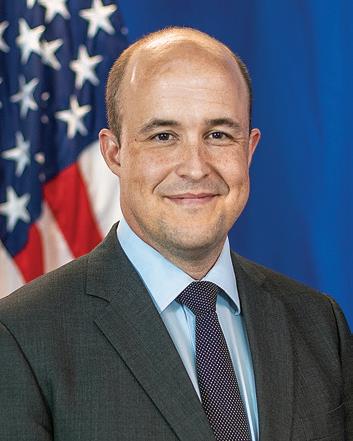
His career has taken him to the Algeria, the Central African Republic, Sudan, and Washington, D.C. He’s now the deputy chief of mission and chargé d’affaires a.i. (ad interim) at the U.S. Embassy in Albania, where he serves as the de facto head of the embassy, pending Senate confirmation of a U.S. ambassador to the southeastern European nation, a NATO ally. “What I love about the State Department is that you have an opportunity to serve the United
States, this country that’s given us all so much, in a way that is varied,” he says.
Not only has he been able to live all over the world, but he has also been able to build expertise in a range of areas. Before heading to Albania, he led the State Department’s Office of Global Food Security, which aims to fight hunger and help the world’s poorest increase food production and adapt agriculture to climate change.
“Every two to three years, I have a new opportunity to learn about a place, and live it, experience it, and hopefully give back to it,” Wisner says.
All that travel has its challenges, however, particularly now that he’s married with two young children.
“It’s both an adventure and at the same time, difficult,” Wisner says. “You uproot your family, you ask your spouse to make sacrifices for your career, you ask your kids to change schools and make new friends every one to four [or so] years.”
What keeps him going is his faith in the work he does. “You have to believe in—at least, I have found—the
ultimately constructive role that the United States plays in the world,” he says.
He was recently able to help forge a deal for the Albanian military to buy U.S. helicopters, he said by way of example; the partnership will support U.S. jobs while providing Albania with equipment it needs to fight wildfires and contribute to NATO operations around the globe.
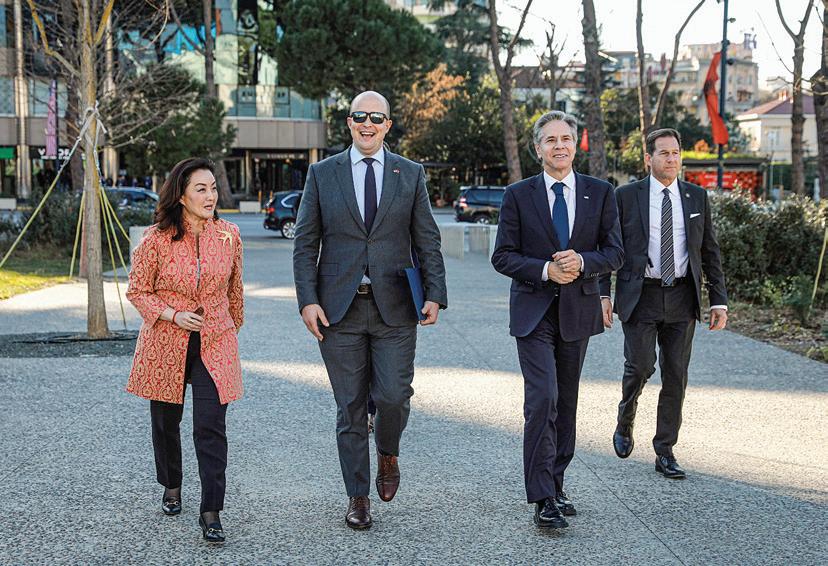

In his prior role leading the Office of Global Food Security, he was able to help mobilize millions of dollars of food research funding that will benefit people all over the world.
“I [was able] to contribute to all of those things. It’s immensely rewarding,” Wisner says.
If there’s a throughline to Wisner’s career, it’s a focus on service, he says. “It goes back to the Taft motto.”
The idea that you should use your skills and education to help others, he says, “is one of those things that I took from Lance Odden, Willy MacMullen, Jon Willson, and all these incredible teachers that I had.” B
—Sophie Quinton ’06 Opposite page: David Wisner ’00, deputy chief of mission and chargé d’affaires a.i., of the U.S. Embassy in Tirana, Albania, with his son, Silas, at ceremonies celebrating Veterans Day in Korçë, Albania. ANTONIO CAKSHIRI Right: Secretary of State Antony Blinken (center right) during his first visit to Albania in February with Wisner (center left). ANTONIO CAKSHIRI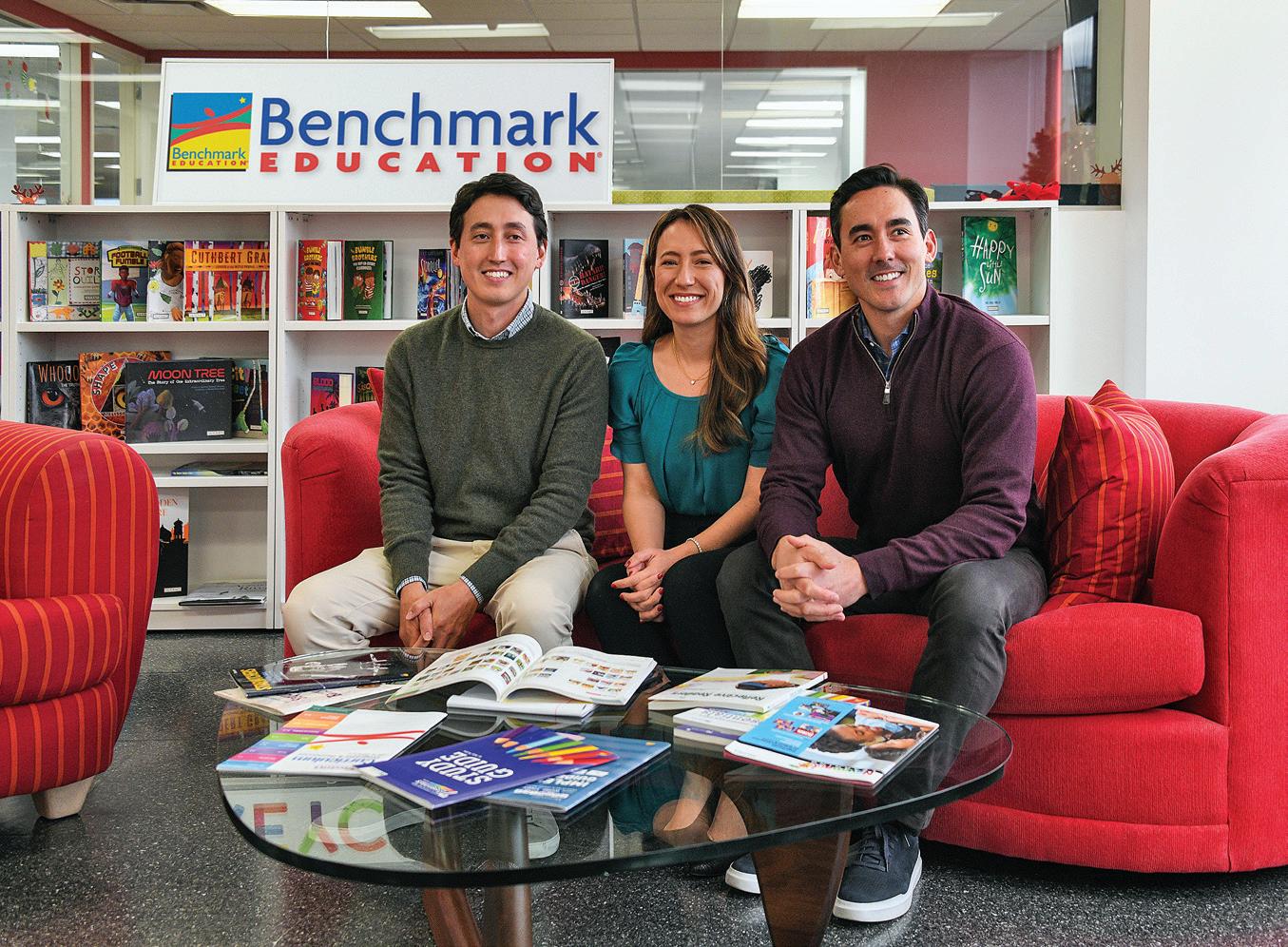
“I ALWAYS WANTED TO BE HERE . I knew from the moment our parents started this business that I wanted one day to carry it forward,” says Will Reycraft ’04, who, along with his sister, Sera Reycraft Hoffman ’02, and brother Thad Reycraft ’10, helps run their family’s business, Benchmark Education Company (BEC). Their sister, Meta Reycraft Fallon ’07, serves as a BEC advisory board member while working as an account director at Salesforce.
What began as a small operation run out of their parents’ basement 25 years ago, has grown into one of the nation’s leading producers of educational programs and resources, with a presence in 70% of all U.S. school districts and an additional 35 countries around the globe.
“Our dad had been in the educational publishing business for a long time, and he often heard from teachers who were looking for opportunities to teach individual
content areas—science, math, and social studies—while also building their students’ literacy and language skills,” Sera says. “He was thinking about starting his own business, and finally our mom said to him, ‘If you want to do this, let’s make it happen.’”
Determined to address that need, BEC soon pioneered a new approach to education, creating resources that taught specific subjects while simultaneously developing students’ reading comprehension. “To take
Above: Three Reycraft family siblings at their family business, Benchmark Education; from left, Thad Reycraft ’10, Sera Reycraft Hoffman ’02, and Will Reycraft ’04. BENCHMARK EDUCATION CO.
a simple example,” Sera says, “say students are reading an earth science text. The passage in front of them will include all of the information they need to learn, but it will be what we call a ‘complex text’ that requires them to unpack various language structures in order to digest the content.”
Passionate about literacy, the team at BEC is committed to reaching as many classrooms as possible. From the company’s inception, they have adapted all of their content into Spanish, growing into one of the largest publishers of Spanish literacy materials for students in pre-K through fifth grade. With the emergence of new technologies, they now create digital versions of their entire print catalog. They have also always put a particular focus on supporting learners who may require more help than their peers, with dedicated resources for individual intervention, special education, and summer schools.
So when Will and Sera—who spent spring breaks and summer vacations pitching in at BEC, sometimes joined by their Taft roommates—saw the impact that their
parents were having, they were eager to be a part of their vision. Sera, who earned a master’s degree from Columbia University’s Teachers College with a concentration in language literacy and technology, officially joined BEC in 2008, while Will stepped away for a few years to gain experience as an analyst and work at a venture capital growth equity firm before returning to the company in 2013. They have worked side by side ever since (quite literally, considering that their desks are in the same room). Sera, in her capacity as co-president, focuses primarily on product development and marketing, and Will, also co-president, oversees the sales, professional development, finance, and technology teams. Their brother, Thad, who earned an MBA from Cornell University and previously worked at IBM, is now director of platform product management.
While each sibling manages his or her own aspects of the business, they have also taken a page out of their parents’ playbook and are in constant contact, always ready to provide feedback and support. It’s an approach that extends not only to the
running of BEC but also to the creation of new materials. “We say in every department—whether you’re in accounting or training teachers or working on new technology—you are learning about what our customers need,” Sera says. “Our parents have done a great job building this team over the last 25 years,” Will adds. “We spend a lot of time in the field and out in schools listening to education leaders, superintendents, and teachers, and their feedback really dictates what we create.”
In recent years, as they have each become parents themselves, both Will and Sera have found an even closer connection to BEC’s mission. “This is work that we take personally. It’s not just about getting a product out the door. To create materials that are going to be used by millions of students and teachers throughout the country, that’s a huge responsibility,” Will says. “And now it’s become how we teach our own children to read. It just brings that much more meaning to what we do.” B
—Christopher Browner ’12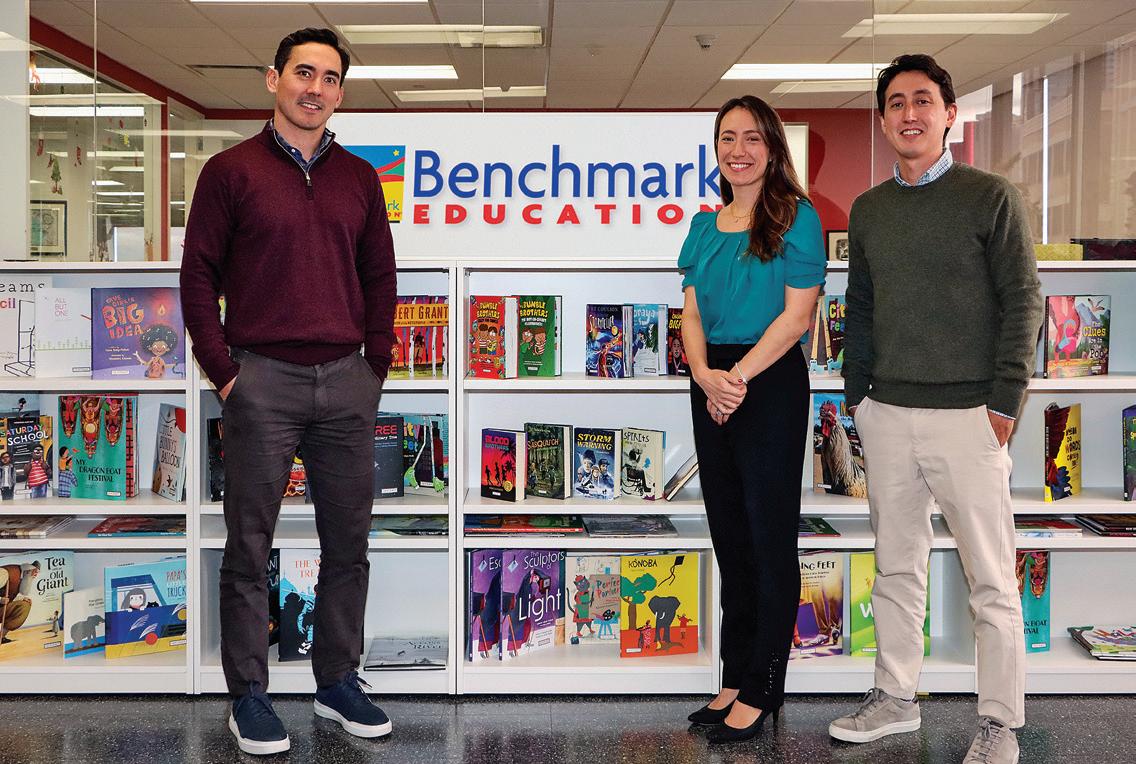

ERIC DELAPENHA ’13 HAD PLANNED to become a doctor. Instead, he became an expert in the biology of hair.
Always intrigued with the intersection of biology and technology, Delapenha veered away from medical school into the innovative world of biotechnology, specifically the science of hair care. As CEO and founder of Strands Hair Care and The Hair Lab by Strands, Delapenha blends individual results with mass marketing.
Traditional hair care is a guessing game, he says, with most people not knowing the unique ingredients they should seek out to address their particular concerns. The Strands concept is simple: Each person’s scalp and hair are different, so each person

has unique needs that can be addressed through individually crafted shampoos and conditioners. Based on a physiological analysis of hair and sebum samples sent to the Strands’ lab in California, a unique formulation is crafted to meet specific hair needs, such as combatting dryness or frizz. The resulting formulation is then shipped to customers, and the company promises that customers will see better hair results within a month of use.
“There are very few...innovations in hair testing and formulations,” he says. “There really isn’t anyone analyzing hair biology today. What becomes harder in establishing a company like Strands, is the more unique you are, the harder and more expensive it
is to educate the consumer when you’re the first. We’re fortunately in a position now where it’s running on all cylinders. Strands is the first company to introduce consumer hair testing and created the ‘test, learn, and customize’ concept. That was the inspiration for creating Strands.”
Hair samples submitted to Strands are subjected to 85 points of analysis, from the condition of the cuticle of the hair, to the protein composition, sebum,
Above left: An array of products from The Hair Lab by Strands. STRANDS HAIR CARE
and porosity of the strands, with chemists, stylists, and bioengineers involved in developing each customer’s unique blend. Strands’ online-only business has taken off, thanks to social media sites like TikTok and to the support of influencers drawn to the unique formulations that address everything from dandruff to split ends.
Delapenha’s other business, The Hair Lab by Strands, is now available in 2,800 Walmart stores. It’s Strands, but on a massive scale. Using a hand-held tester in select stores, shoppers can quickly analyze 26 different aspects of their hair to find their best formulation among the products on the shelves at the store. By adding need-specific “doses” into shampoo
and conditioner bases, shoppers can customize their formulations at home.
“We’re able to give everyone access to customized hair care based on their hair’s biology—not assumptions or guesswork—at prices that don’t leave anybody out,” he promises.
Today, Delapenha’s focus is on innovation and increasing distribution.
“How do we address unmet needs in the market?” he says. “There’s an actual true need and market opportunity. In research and development, every week we are looking at pricing and costs so we can see if we can keep it affordable and efficacious.”
There’s a worldwide market for this kind of specialized hair care, he says. “In the next

five years, we’re rapidly growing our hair care products by expanding distribution. We’re eyeing some very lucrative partnerships.”
“There is an incredible amount of room for growth. That’s just for hair in the United States. We really do see a strong need for customized hair, skin, and body needs,” he said.
Hair care is a crowded field, he says. “ The ease with which people start companies is accelerating—setting up a website with a few clicks, putting the beautiful, sexy branding on it, and making it seem new and innovative. It’s been very easy to set up a new brand in a crowded space, but there are very few brands customizing efficacious products. There’s a lot of brands that can pop up a quiz that drives users to standardized products in their line or offers slightly tweaked formulations, but it’s not through individual hair strand analysis.”
“Things that get me really excited are… pushing the envelope on innovation,” he says. “There’s a moment that you build towards—the moment that always stands out—when you and the team have put thousands of hours into this, and you start to see your first shoppers flowing in, and you begin to get feedback from customers.” B
—Bonnie Blackburn-Penhollow ’84

PRIOR TO THE COVID PANDEMIC, many people probably didn’t think too much about how goods travel the world. We just expect what we want to be on shelves when we want them. The pandemic highlighted
the reliance on the supply chain via trucks, trains, planes, and ships that transport everything from soup spoons to aircraft parts across the globe. Sarah Richards Hedges ’88 has been a part of managing
that supply chain for almost three decades. Hedges works as a manager in information services at Expeditors International in Seattle, Washington, which is a multinational company that provides
Left: Sarah Richards Hedges ’88 on one of many container vessels that play a big part in her work for Expeditors International.transportation of goods while navigating delicate geopolitical customs. The logistics of the supply chain industry have changed enormously over the past 30 years.
“When I started, the internet was in its infancy,” she says. “The industry relied on a lot of paper, and visibility to supply chains relied on Excel reports.”
Think about the process: A garment is made in a factory in Bangladesh, and it’s destined for a shop in New York City. To get that dress to the shop floor, there are hundreds of steps that must be taken in the correct order, at the correct time, relying on myriad computer systems operated by people who use a wide variety of languages.
“With all the changes to technology, the need for visibility to one’s supply chain has dramatically changed from when the ‘visibility’ tools were faxed or emailed Excel spreadsheets. Now customers expect data [to be] sent to them electronically, and it
needs to feed their enterprise resource planning (ERP) systems. Customers require real-time information, and this must be sent electronically based on shipment milestones. If it’s not sent electronically, then customers require the ability to track and trace their shipments online or via Android or ios applications.”
In addition to those challenges, Hedges says the sector has had more compliance and security regulations come into play in a post-9/11 environment, which adds complexities to the supply chain.
“In IT, it’s challenging,” she says. “I’ve never been an analyst or a developer. I was hired to be a people manager. I’m trying to help my team grow their careers and prioritize the work, and I insulate them from some of the stressors” that come with the business.
Typical days include many Zoom calls between Expeditors’ 175 offices across the globe. “Most days are filled with touching

base with my leadership team, some of whom work in Chennai, India, whether that be my peers and senior management or meeting with the management team who reports to me,” she says. “We meet in order to understand the work being requested and how to balance and juggle resources in order to meet deadlines. It takes a great deal of coordination, communication, planning and follow-through among all parties in the supply chain, from the buyers ordering the merchandise, to the parties manufacturing the goods, all the way through to delivery to the final destination point.”
Hedges says the satisfaction of hitting aggressive delivery deadlines outweighs the challenges of weather delays, accidents, or other hiccups that might affect deliveries.
The logistics industry has also gained greater visibility since the advent of online shopping giants such as Amazon. “The need for real-time updates that we as consumers expect from our home deliveries has extended to the demand for real-time information in the world of international air and ocean freight, as well as domestic truck and rail cargo,” she notes.
Looking back on her 30-year career, Hedges says she’s stayed with her company because she continues to be challenged.
“Expeditors was my second job after college and as a 23-year-old, I certainly wouldn’t have predicted I would be at a company this long, longer than I had then been alive,” she says. “Going through the dot-com-boom years of the early 2000s when many jumped from company to company, I was surrounded by many capable and caring people who didn’t leave and haven’t left,” Hedges says. “The relationships and friendships I have formed not just in the Seattle area, but around the world, would be hard to find elsewhere. The opportunities I have had to travel to a number of countries with the company have been exciting, as well as the opportunities to make career shifts along the way.” B
—Bonnie Blackburn-Penhollow ’84
THE DEPTH AND BREADTH OF THE academic talent in the Taft community has allowed our faculty to continuously look for and create new opportunities for learning at the highest levels. Enter Dr. Mostafa Mirabi.
With undergraduate and master’s degrees in pure mathematics from Tehran Polytechnic University, Dr. Mirabi spent time as a research scholar at the Institute for Research in Fundamental Science before making his way to Wesleyan University, where he earned a Ph.D. in pure mathematics. His primary research centers around mathematical logic, focusing on model theory and its applications in combinatorics and algebra. At Taft, Dr. Mirabi teaches


a range of high-level courses, including BC-Calculus, Linear Algebra, and Differential Equations. This semester, he is offering one of the highest-level mathematics classes ever taught at Taft: Honors Modern Algebra.
“The class was developed to meet the growing demand for advanced mathematical concepts and to challenge students in abstract reasoning,” explains Dr. Mirabi. “Honors Modern Algebra stands out as the ‘most abstract’ and challenging math course.”
As a discipline, modern algebra—also known as abstract algebra—is rooted in the exploration of group theory. The primary goal for Dr. Mirabi’s students is to explore the Sylow theorem, which states that if we have a group (a mathematical set with a specific operation) with a particular order or size, and if a prime number divides that size, then the group contains a subgroup of that size.
“The theorem provides insights into the structure of groups and their subgroups, making it a fundamental tool in group theory,” explains Dr. Mirabi.
And while that may feel like an

abstract concept to some, the applications are both concrete and varied.
“Group theory has numerous applications, including cryptography, coding theory, and symmetry analysis in various scientific fields,” Dr. Mirabi says.
In cryptography, for example, group theory is important in designing secure encryption algorithms by leveraging the mathematical properties of groups. In the surging field of artificial intelligence (AI), group theory can be applied to recognize and classify patterns, contributing to image and signal processing in AI systems. In physics (specifically quantum mechanics), group theory is used to understand the behavior of particles and the structure of atomic orbitals, while in biology, group theory helps scientists analyze the symmetrical properties of biological molecules in the study of protein structures. It also has powerful and practical applications in chemistry, engineering, geometry and topology, economics, music, and more.
Honors Modern Algebra is designed for students who are passionate about theoretical mathematics and who are looking for a
rigorous intellectual challenge. Eleven students are currently enrolled in the course, among them, Martyna Glowacka ’25.
“I decided to enroll in Honors Modern Algebra because of the unique perspective on mathematics this class provides,” says Martyna. “The course is proof-based, which, in my view, is the essence of mathematics. This approach not only allows me and other students to understand the theory thoroughly, but also discover new connections between different portions of the material.”
Discovering connections within the material is an element of learning that also speaks to Vincent Chen ’24.
“Dr. Mirabi provides students with ample time for independent thought, encouraging us to explore connections between the steps of proofs. Moreover, he consistently places new topics within a broader context, using them to clarify fundamental concepts. This approach shattered my preconception that math is a dull, linear process. Beyond being an exceptional lecturer, Dr. Mirabi is a very dedicated teacher. His teaching style has significantly altered my perspective on mathematics.” B
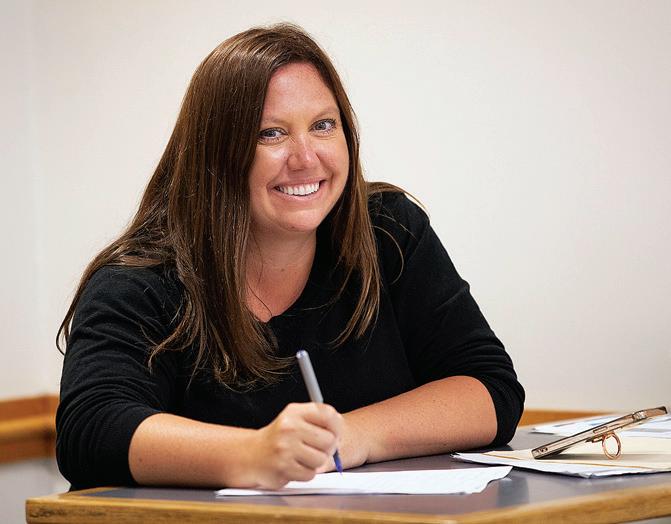
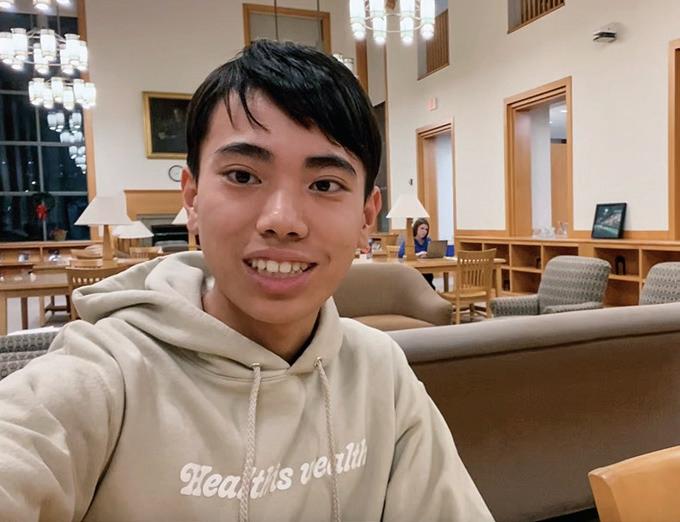
While the question may seem daunting, it is one students in Brianne Foley’s Honors Seminar in Economic Research are working to answer.
“Each student wrote a very significant—epic, really—research paper on a topic of their choosing,” explains Foley. “They were also tasked with defending their theses in presentations to an audience that included classmates, faculty members, and school administrators. This is high-level and challenging work.”
Honors Seminar in Economic Research is an advanced-level research class designed to help students further develop their research skills through deep dives and thoughtful exploration into current and global economic issues. The students marry applied critical thinking skills with the foundational understanding of economic theory—economic indicators, development, government policy, market structures, labor markets, game
theory, externalities—gleaned through their prior economics and mathematics courses. For many, the research topics were personal.
“I visited Shanghai for the first time when I was 7, and I was fascinated by the contrast between the west and east sides of its Bund. On the west side, there are immense colonial structures in Gothic, Neoclassical, and Baroque architectural styles. On the east side, there are futuristic skyscrapers that sprouted up in the past four decades. As a 7-year-old, I never really investigated this further,” says Spencer Louie ’24. “During the past semester, I researched where it all began. I delved into China’s treaty port era, also known as the ‘century of humiliation’ and as a period of ‘unequal treaties.’” Investigating this period in China, I learned about the long-term economic impacts that it had. It explains a lot of China’s economic growth in the past four decades that has astonished everyone.”
For others, their work was an effort to help understand and contextualize
issues affecting Taft students.
“I researched the 1973 Cold War oil crisis, and connected it with the IsraelPalestine and Russia-Ukraine conflicts occurring now,” explains Anmay Suri ’24.
“I wanted to research this because of the way these current global events are impacting our Taft community—the Russia-Ukraine conflict and the Israel-Palestine conflict and all the communities that are affected by both. For me, the most impactful part of the research was just seeing the history and the trajectory of how oil crises align with different areas of conflict, as well
Above left: Honors Seminar in Economic Research Teacher, History Department Head, and Assistant Director of the Global Leadership Institute Brianne Foley.
Above right: “One of the best parts of the class for me was being able to access the resources in Taft’s library. With more than 55,000 books and 70 databases, there were many ways for me to pursue my research into the pharmaceutical industry and the inefficiencies in its current patent structure.” —Michael Xu ’25

as how they affect the global market.”
Topics ranged from basic financial literacy to the modern defense industry to studies of the film and pharmaceutical industries.
Overall, the research was formidable, notes Foley, but also rewarding. For some, it may simply be a starting point.
“For me, learning how different the experience of going back to China is knowing this history is significant,” notes Louie. “But I realized that there is still so much to uncover about this fascinating topic—how many different avenues there are left for me to explore.” B
Above:
Below: From Rina Kurihara ’24’s research paper: The graph maps Japan’s GDP per capita growth from 1873 to 2020 by using data from the Maddison Project. The red line outlines Japan’s GDP per capita growth until the start of the Pacific War. The yellow line, “Predicted, without war” predicts Japan’s GDP per capita growth without war. The blue line outlines Japan’s actual GDP per capita growth from the Pacific War to 2020.

Rina Kurihara ’24
The Pacific War: Justification of War as a Long-Run Economic Solution
Spencer J. Louie ’24
The Paradox of Power: Western Intervention in 19th-Century China and the Making of China’s Post-1978 Economy
Max Rivera ’24
Hispanic Migration: Dissecting the Low-Skilled Labor Market and Analyzing the Future of the U.S. Economy
Roman Rosenberg ’24
Financial Literacy: Understanding the Benefits of a Financially Literate Population
Anmay K. Suri ’24
The Prevention of a ConflictMotivated Oil Crisis in the United States of America
William Theiss ’24
The Modern Defense Industry: An Analysis of the Military Industrial Complex
Michael Xu ’25
Problematic Patents and Pharmaceutical
Prosperity: Potentiating Producers, Patients, and Policymakers
Steven Yang ’24
The Short- and Long-Term Consequences of the Chinese “Third Child” Policy
Luke Zhang ’24
Navigating the Evolving Landscape and Sustainability of the Film Industry: Streaming Revolution, Government Policies, and Cultural Impacts
Using an audio mixer visual, Max Rivera ’24 tapped into his work as a DJ to explain his labor-market theory as it relates to Latino immigration. Scan this QR code on your smart phone to watch Max’s video.

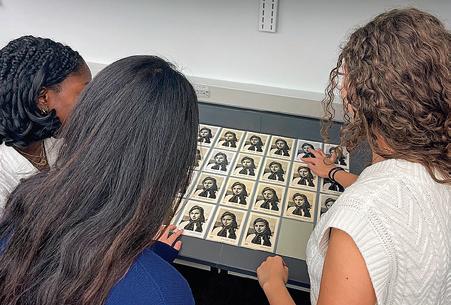
LESS THAN AN HOUR FROM TAFT’S campus is an extraordinary collection of art—a gallery housing more than 300,000 pieces. Founded in 1832, The Yale University Art Gallery is the oldest university art museum in America. It is a center for teaching, learning, and scholarship and is a preeminent cultural asset for Yale University, the wider academic community, and the public, including students in Alex Werrell’s Honors Western Art History class. Classroom learning came to life as Werrell and his students married their knowledge of specific pieces— and of art, in general—with the works before them in the gallery.
“As we walked in the ancient wing of the gallery, we spotted marble sculptures, reliefs, pottery, and mosaics,”
Above:
Below:
 The class in front of Titus Kaphar’s Shadows of Liberty
Left: Elise Taylor ’24 and Isabella Nascimento ’25 in front of Vincent van Gogh’s Le café de nuit
A class selfie in front of a floor mosaic from Gerasa (modern Jordan) depicting the Egyptian cities of Alexandria and Memphis. Yale excavated the mosaic at a school-sponsored dig in 1932.
The class in front of Titus Kaphar’s Shadows of Liberty
Left: Elise Taylor ’24 and Isabella Nascimento ’25 in front of Vincent van Gogh’s Le café de nuit
A class selfie in front of a floor mosaic from Gerasa (modern Jordan) depicting the Egyptian cities of Alexandria and Memphis. Yale excavated the mosaic at a school-sponsored dig in 1932.
recalls Isabella Nascimento ’25. “It was interesting to see the traces of pigment on several reliefs, which provided a reallife example of our ongoing conversation about what art was back then and how it is interpreted today. Likewise, walking along the gallery, we discussed how the political and cultural might of empires is reflected in art itself and the preservation of these pieces, like the ancient city of Dura-Europos and the Roman Empire.”
Connecting with specific pieces began with Shadows of Liberty, a piece by Titus Kaphar.
“Kaphar is an artist working now in New Haven whose series, From a Tropical Space, we have studied closely,” notes Werrell. “The piece we viewed features a characteristic Kaphar approach: A classical, traditional portrait of George Washington as military leader is subverted by the blown-out hellscape in which he is situated and by the strips of paper hanging from the president’s face and neck. Just as Martin Luther sought to reform the church, Kaphar seeks to reform history. He hammered the strips with rusted nails directly through the canvas; each strip has the name of one of the hundreds of men and women and children Washington enslaved at Mount Vernon.”
Students also visited the Photography Lab at the Institute for the Preservation of Cultural Heritage, where they learned about conservation practices and sciences at Yale. They had a chance to see massive drafts of Edwin Austin Abbey’s ceiling murals, taxidermized reptiles and birds, photographs from the earliest days of photography, and even a few Renaissance pieces being touched up with lapis lazuli. Students also learned a lot about the challenges facing photography collections, including how the spectacular array of photography paper textures, thicknesses, tones, and more alter a photo.
“It was an incredible oportunity to learn more about the science behind art conservation and preservation,” says Isabella. B
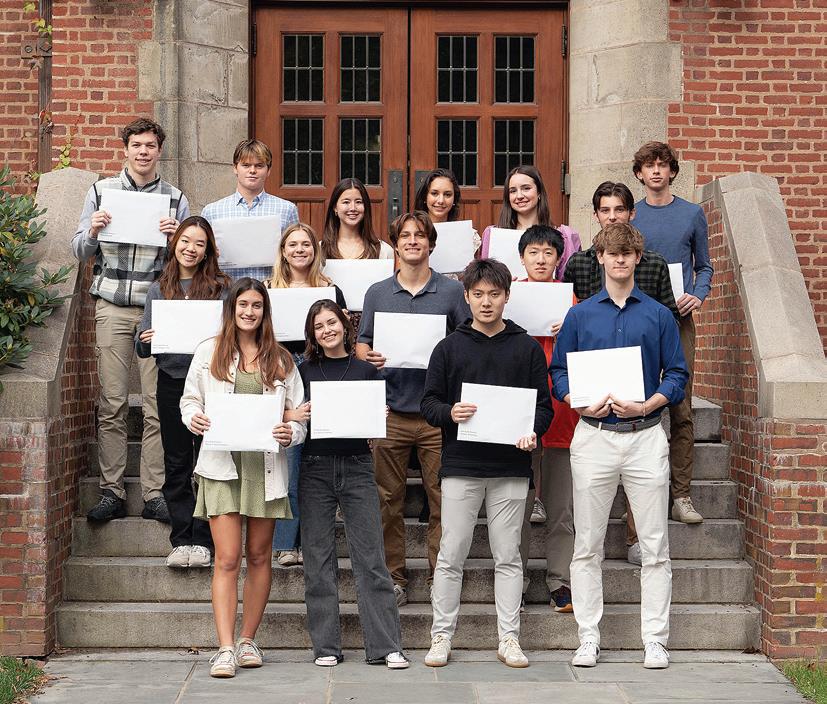
“CUM LAUDE IS AN EXTRAORDINARY achievement,” noted Head of School Peter Becker ’95 in opening the annual Cum Laude Society induction ceremony. “I’ve always thought that what we recognize isn’t necessarily getting to this point—winning this prize, as it were—but all the effort that it takes to get there and what it signifies, not just about the students who are here on the stage, but the nature of academic pursuit and engagement at Taft more generally: a spirit of inquiry and a spirit of effort and determination in that pursuit that I hope is true of every student at this school.”
Noting that the Cum Laude Society’s Latin motto translates to ‘excellence, justice, and honor,’ Becker said, “I want
us all to see these achievements not as getting to the destination, but as one milestone—the next step in a lifelong journey of learning, inquiry, and growth. There is always a next step toward excellence.”
Founded in 1908, the Cum Laude Society is the national scholarship society in secondary schools, corresponding to Phi Beta Kappa and Sigma Xi in colleges and scientific schools. A maximum of 20% of the senior class may be elected to membership in the Cum Laude Society. Based on their mid and upper mid academic records, 15 members (9%) of the Class of 2024 were inducted into the Cum Laude Society in the fall; a second group will be inducted at Commencement in June. B
Above: New Inductees are, back row, from left, Nikas Lukyanov, Lachlan Abbott, Bryn Gavigan, Ivy Kargman, Sabrina Moffa, Finneas Gateley; middle row, from left, Maggie Zeng, Charlotte Blair, Noah Cinel, Michael Ren, Trevor Stellmach; front row, from left, Caiya Niewinski, Theresa Alves de Oliveira, Luke Zhang, Shane Mettler.
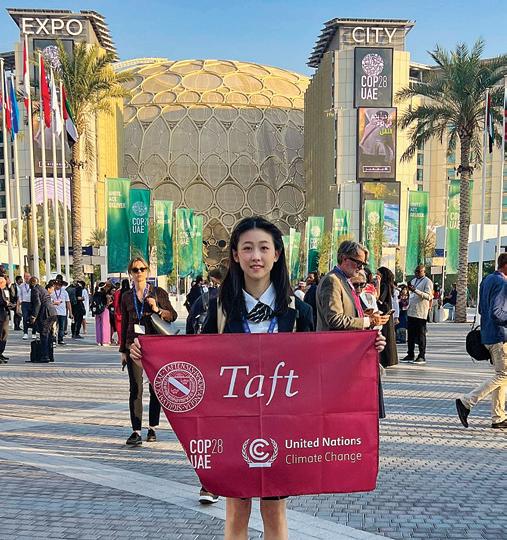

FOR NEARLY TWO WEEKS IN DECEMBER, scientists, government leaders, captains of business and industry, global and regional NGO leader, venture capitalists, entrepreneurs, and climate-change activists were among the 70,000 people gathered in Dubai, United Arab Emirates (UAE), for the 2023 UN Climate Change Conference. The event marked the 28th meeting of the Conference of Parties (COP28) to the United Nation’s climate change accord. This year, a large youth delegation attended a range of events, including Yolanda Wei ’26.
“I have always been focused on environmental protection,” says Yolanda. To date, Yolanda has made three journeys to polar regions as a citizen scientist with research-driven expedition teams. What she learned along the way has shaped her passion, and moved her to act.
“I saw emaciated polar bears, some even perishing due to the diminishing ice floes. The landscape also bore the scars of rising sea temperatures, with extensive areas of sheath plants,” Yolanda recalls. “The diminishing sea area is affecting penguins’ ability to feed on krill. This experience led me to the realization that the environmental impact has now penetrated the last pristine expanse on Earth.”
Through her experiences, Yolanda learned about many organizations working to impact the environment, including the Peaceland Foundation, an international nonprofit organization that offers long-term educational programs addressing global humanitarian crises and environmental challenges, providing an opportunity for youth representatives to get involved. One of those opportunities: a chance to attend COP28.
Yolanda applied, and was chosen to travel to UAE as a global youth representative.
“At COP28 I encountered a diverse group of individuals, including numerous youth representatives, each with their unique advocacies and projects,” says Yolanda. “It was inspiring to witness the determination and efforts of people from all walks of life, all committed to combating climate change.”
Yolanda delivered a speech titled “Our Actions for Our Poles” to COP28 attendees.
“Drawing from my three trips to the polar regions and numerous scientific research projects, I urged everyone to pay attention to climate change,” Yolanda explains. “I believe that young people should have rich and formal knowledge about this, the defining issue of our time. Scientific research is one of the significant contributions young people can make to stop global warming.” B
Left: Yolanda Wei delivered a speech titled “Our Actions for Our Poles” to COP28 attendees. Above top: Yolanda traveled with the Taft banner to show the school’s support for climate action.
The Taft community has been exploring all things AI from a range of perspectives. Taft’s AI Taskforce has been leading the charge on the substantial work underway by our faculty. Taft students are also actively involved in the conversation. From left in photo: On behalf of the Taskforce, Academic Dean Jennifer Kenerson welcomed Charlotte Blair ’24, Sally Higgins ’25, Elise Taylor ’24, Michael Werblow ’26, Michael Xu ’25, and Bernice Zhang ’27 to a faculty meeting in Bingham Auditorium to answer previously submitted questions about AI. “It was a fascinating panel discussion about the role AI plays in teenagers’ lives,” says Assistant Head of School for Faculty and Academics Edie Traina. “The students shared valuable insights about the impact of emerging technology in both professional and personal realms. It is also a wonderful example of our thoughtful and talented student community.”

Dan Calore’s engineering students have been studying the practical elements and application of the Arduino, an open-source electronics platform based on easy-touse hardware and software. Arduino boards can read input—such as lights on a sensor—and turn it into an output—such as activating a motor or turning on an LED. Students tell the board what to do by sending a set of instructions to the microcontroller using the Arduino programming language and the Arduino Software (IDE).
EACH YEAR, the National Association of Independent Schools (NAIS) hosts a multiday, international People of Color Conference. Ten Taft faculty members and six Taft students were among the 8,000 students, educators, and administrators to travel to St. Louis, Missouri, for the most recent People of Color Conference, which explored concepts of truth, knowledge, optimism, joy, and power.
An exciting component of the annual event is the Student Diversity Leadership Conference (SDLC), a companion program
for student leaders. SDLC is a multiracial, multicultural gathering of student leaders from independent high schools across the U.S. and abroad. Driven by this year’s theme—Bending the Arc Toward Justice: Radical Optimism, Transformational Joy, Resilience, and Brilliance—SDLC attendees engaged in self-reflection, found allies, and worked to build community. Led by a diverse team of trained adult and peer facilitators, participants also developed cross-cultural communication skills,
designed effective strategies for social justice practice through dialogue and the arts, and learned about the foundations of allyship and networking principles. In addition to large group sessions, SDLC “family groups” and “home groups” allowed for more intimate dialogue and sharing. B
SDLC attendees, from left: Director of Multicultural Recruitment Shanique Garcia, Jasmine Pun ’24, Maya Lewis ’24, Samaad Brown ’25, Muthoni Gichingiri ’25, Leo Pineda ’25, Kojo Asmah ’24.


TAFT’S MARTIN LUTHER KING JR. DAY celebration began with a compelling talk by Dean of Community, Justice, and Belonging Thomas Allen. Mr. Allen shared thoughts on both the widely and lesser-known aspects of Dr. King’s life, and considered how his work and principles can shape how we work, connect, and respect one another.
Later in the day, students gathered in small, faculty-led groups to identify ways to use lessons from Dr. King in our life and work as a school community. Specifically, Allen asked students to consider actions built around five key concepts: serving others; standing up for what is right; committing to the principles of love, beauty, and justice; never giving up; and believing that all things are possible. B
ONE OF TAFT’S GREAT TRADITIONS, MORNING MEETING TALKS EDUCATE AND INFORM, RAISE CONSCIOUSNESS AND AWARENESS, PLANT SEEDS, GROW UNDERSTANDING, AND INCREASE THE DEPTH AND BREADTH OF KNOWLEDGE STUDENTS CARRY WITH THEM LONG AFTER THEY LEAVE TAFT. THIS IS JUST A SAMPLING OF SOME OF THE SPEAKERS WHO FILLED BINGHAM AUDITORIUM WITH IDEAS DURING THIS ACADEMIC YEAR.

Seven Taft students reflected on the “unsung heroes of the Civil Rights Movement,” during a well-researched, powerful, and important Morning Meeting. Muthoni Gichingiri ’25 introduced the Taft community to the Rev. Dr. Pauli Murray. Murray’s work as a civil rights activist, advocate, legal scholar and theorist, author, and Episcopal priest advanced the movement and led to expanded legal protection for gender equality.
“And so what? What does that have to do with us? What does that have to do with our motto, Non ut sibi,” Muthoni asked of Murray’s work. “Rev. Dr. Pauli Murray wrote, ‘When my brothers try to draw a
circle to exclude me, I shall draw a larger circle to include them.’ I think this quote has a lot to do with how being part of a community such as this takes work. Whose voices can we augment, and what circles can we draw to call each other in and not out?”
Kaylee Graham ’26, Jasmine Pun ’25, Sarah Rochester ’26, Ny’Ana Hauser ’25, Elise Taylor ’24, and Maya Lewis ’24 spoke of the lives and work of unsung heroes Angela Davis, Ella Baker, Claudette Colvin, Diane Nash, bell hooks, and Mamie Till-Mobely.
After completing his military service and establishing himself as a physician, Dr. Thomas Gross ’69 found himself feeling that something was missing—Holocaust survivor and psychiatrist Dr. Viktor Frankl’s “higher


calling,” he said. Dr. Gross returned to military service part time with the California National Guard. “The answer is encoded even in the Taft School motto. I am not talking just about military service, but service to your community, however you define it, be it your family, local community, perhaps a congregation, your country, or even humanity at large,” said Dr. Gross. “I can tell you that devoting some portion of your life in service to something greater than yourself will bring a satisfaction and peace of mind which you might not expect.” Dr. Gross recently retired from the New Hampshire Air National Guard with 22 years of military service, which included 58 combat missions as a helicopter crewman and physician with the 129th Expeditionary Rescue Squadron in Operation Iraqi Freedom.
After Maria Hinojosa visited Taft last year, her book, Once I Was You, was named the all-school summer read. Hinojosa returned to Taft last fall to close the circle. In addition to delivering a speech in Bingham, Hinojosa visited classes and led a Q&A session in the Faculty Room. Hinojosa’s 30-year career as an award-winning journalist includes reporting for PBS, CBS, WNBC, CNN, NPR, and anchoring the Emmy Award-winning talk show from WGBH
Maria Hinojosa: One-on-One. A Pulitzer Prize and Peabody Award winner, she was recently named an Edward R. Murrow Lifetime Achievement Award recipient. She is also the author of two other books and has won four Emmys, the John Chancellor Award, the Studs Terkel Community
Media Award, two Robert F. Kennedy Awards, and the Ruben Salazar Lifetime Achievement Award, to name just a few.
Monks from Tibet’s Drepung Gomang Monastery returned to Taft this year for a weeklong campus residency, which began with a traditional and fascinating Morning Meeting welcome ceremony. During their time on campus the group meticulously created an interfaith peace mandala of colored sand in the Potter Gallery, visited philosophy and religion classes, and met informally with members of the Taft community. Their work culminated in a dissolution ceremony, where the mandala was ceremoniously swept up, then returned to the sacred waters of the earth—a reflection on the impermanent nature of life and the importance of living with compassion.

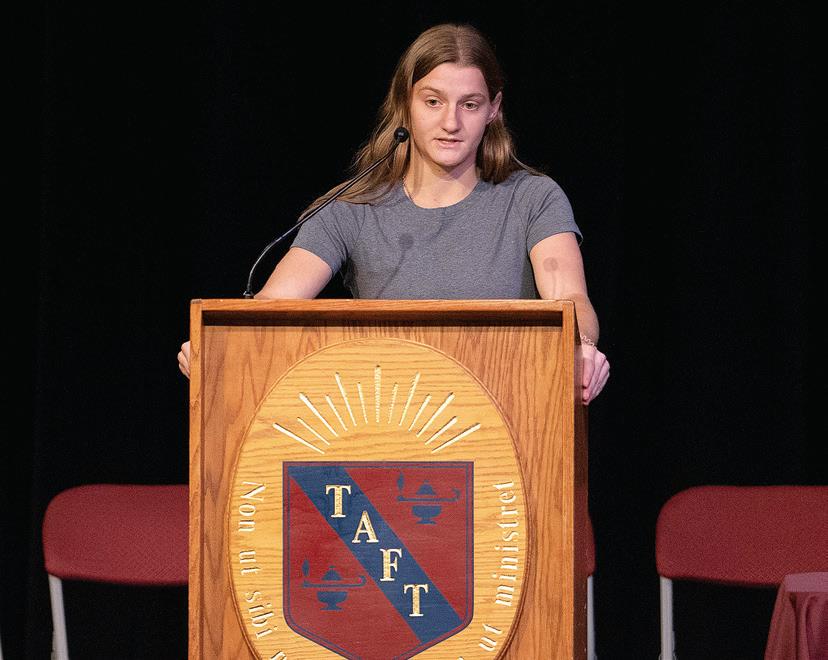
For 35 years, National Coming Out Day has commemorated the 1987 National March on Washington for Lesbian and Gay Rights; the date honors the bravery of LGBTQ+ individuals who decide to come out and live openly. Rachel Turer ’25 and Head of School Peter Becker ’95 shared their thoughts on National Coming Out Day during a Morning Meeting, which included reflections on the specific challenges faced by LGBTQ+ youth.
As a young cardiology fellow, Dr. Christopher Kerr began working a side gig at a local hospice. Today, he is the chief executive and medical officer at Hospice and Palliative Care, Buffalo, New York, and has dedicated his career to understanding the experiences of dying patients. Kerr has observed that there is an experiential side to death that is almost universal: Patients have powerful inner experiences as they near death—dreams, of sorts—that are at once profoundly meaningful and profoundly therapeutic. Patients had many common experiences during these dreams,
including seeing loved ones from their past as death drew nearer. Explained Kerr, “These dreams don’t deny the reality of death, but instead validate the life that was led, and give them comfort going forward.”
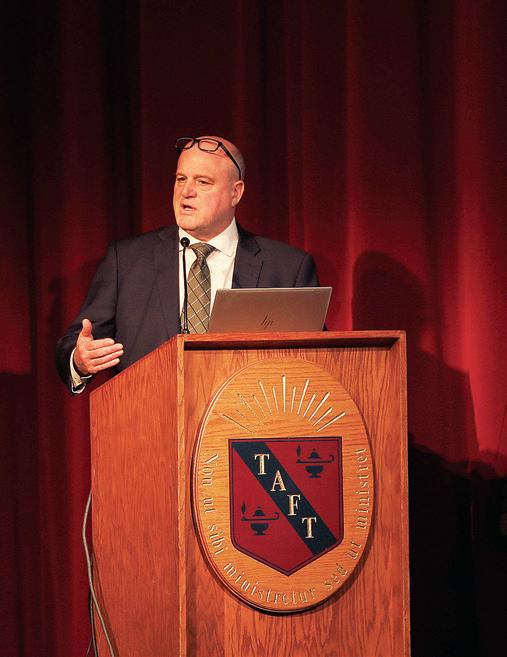



American comedian, director, screenwriter, producer, author, actor, and university film professor Thomas Shadyac was this year’s Paley Lecturer. The youngest joke writer ever for comedian Bob Hope, Shadyac is widely known for writing and directing the comedy films Ace Ventura: Pet Detective, The Nutty Professor, Liar Liar, and Bruce Almighty. In 2010, Shadyac departed from comedic work to write, direct, and narrate the documentary film I Am, in which he explores his abandonment of a materialistic lifestyle following a bicycle accident in 2007.
Established in 2006 by Valerie and Jeffrey Paley ’56, the Paley Family Endowment supports the Paley Lectures, an annual program of visiting speakers who address the school community on current issues of major significance, including government, journalism, foreign affairs, environment, and civil liberties to provide Taft students with the opportunity to be inspired by the value and dignity of lives filled with purpose and commitment. B

AFTER A FIVE-MONTH, NATIONWIDE search, Head of School Peter Becker ’95 has appointed Amanda Bohnsack as Taft’s new director of enrollment. Bohnsack comes to Taft with deep experience in both admissions and secondary school placement, most recently as director of admission at Deerfield Academy.
“Amanda’s love of boarding schools and the students and colleagues who comprise them, strategic thinking, leadership skills, commitment to making schools financially accessible and welcoming to first-generation students, and knowledge of the boarding school market position her to lead and grow Taft’s enrollment efforts and serve as a key member of Taft’s administrative team,” Becker said.
The search was led by the executive search firm Isaacson, Miller. Two search advisory committees comprised of employees and trustees helped steer the search. The trustee committee was headed by J. Kingman Gordon ’88, P’27 and included Henry Brauer ’74, P’08,’09,’10, Katama Guernsey Eastman ’95, P’22,’24,’26, Michael Humphreys ’93, and Kate Genung Taylor ’94, P’27.
“The trustee search advisory committee was thoroughly impressed with Amanda’s qualifications and experience,” said Gordon. “It’s a monumental task to follow in the steps of Peter Frew ’75 and Ferdie Wandelt ’66, but we’re so fortunate to have found the perfect person in Amanda to move Taft’s enrollment work forward.”
At Deerfield, Bohnsack directly
supervised a team of 12 admissions professionals and 36 faculty readers in a highly selective admissions process. Prior to her tenure at Deerfield, she was senior associate director of admission at Hotchkiss and then served as the director of secondary school advising at Greenwich Country Day School, guiding families through the high school search and placement process.
At Taft, Bohnsack will lead the 20-member Admissions Office, working closely with Head of School Peter Becker ’95 and Taft’s senior administrative team and board of trustees. She will be responsible for maintaining and strengthening Taft’s position in the independent school marketplace, ensuring the enrollment of mission-appropriate students, and serving as a key ambassador for the school.
Bohnsack inherits a committed team and the legacy of outgoing Director of Admissions Peter Frew ’75, who has played a crucial role in shaping Taft’s admissions success since 1985.
“As we look forward to welcoming Amanda to our community in July 2024, I want to express my gratitude to Peter Frew ’75 for his dedication and contributions over the years,” Becker said. “Under his leadership, Taft has enrolled exceptional, competitive, and diverse classes, and we are grateful for his service. I know I speak for so many fellow alumni and Taft families when I express my gratitude for his holistic service to Taft and the sense of humor and positive energy he’s brought to Main Hall every day.” B

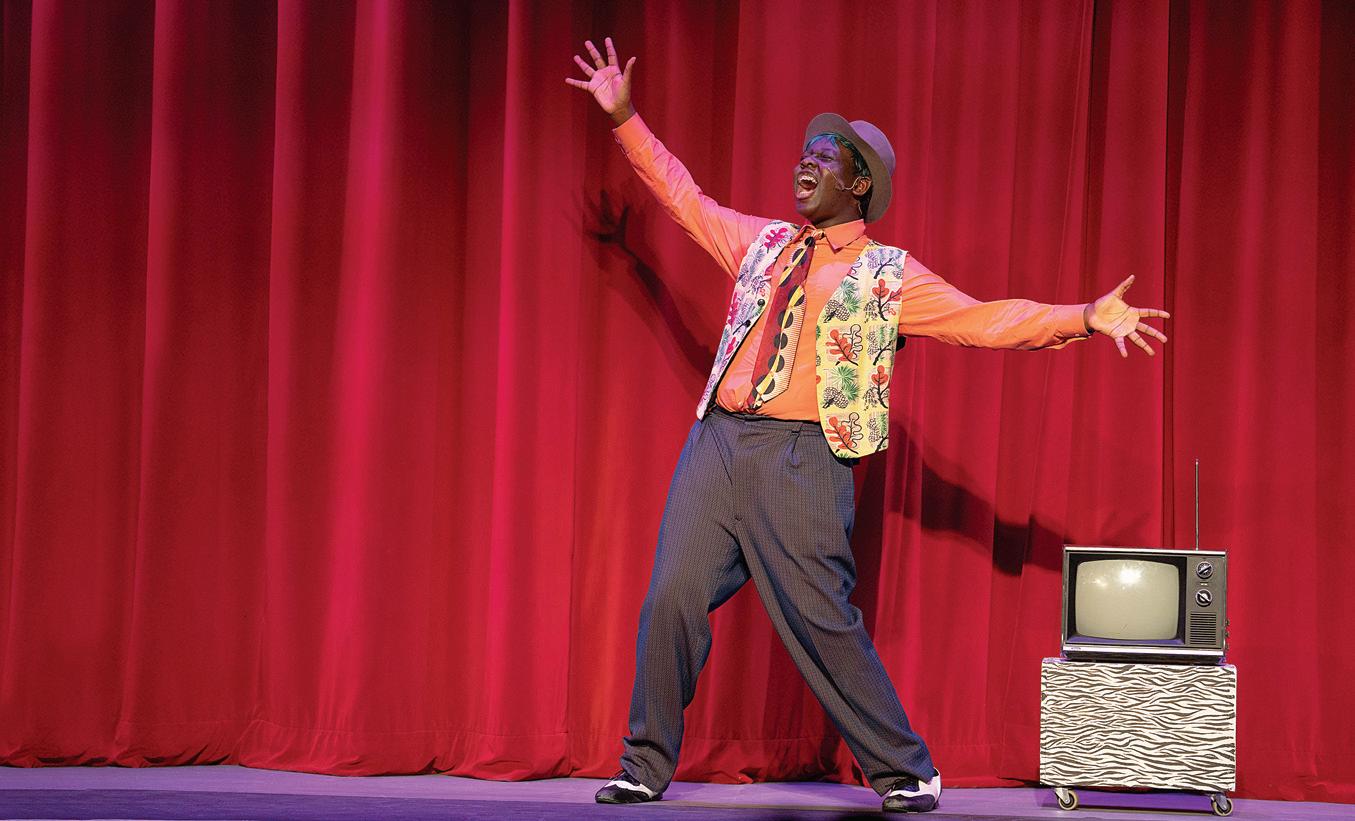
MATILDA WORMWOOD IS A PRECOCIOUS CHILD WHO LOVES TO READ. IT’S HER TELEKINETIC POWERS, THOUGH, THAT HELP HER NAVIGATE OBSTACLES AT HOME AND AT SCHOOL, AND FORM A BOND WITH HER TEACHER. IT’S A STORY OF AN EXCEPTIONAL CHILD, STAGED BY TAFT’S EXCEPTIONAL ACTORS, DANCERS, MUSICIANS, LIGHTS AND SOUND TEAMS, AND STAGE CREW.
Roald Dahl’s Matilda the Musical was presented through special arrangement with Music Theater International (MTI). All authorized performance materials were also supplied by MTI.
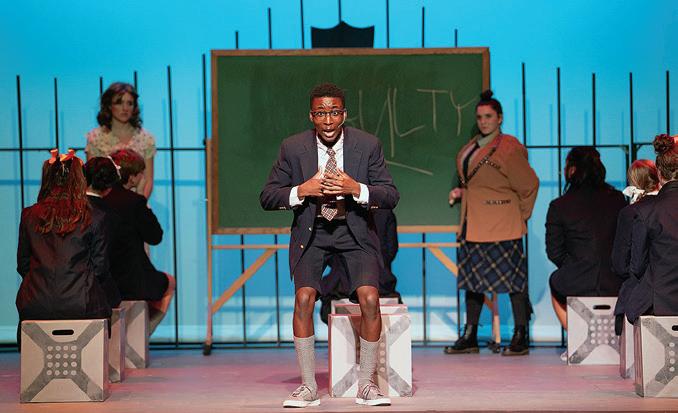
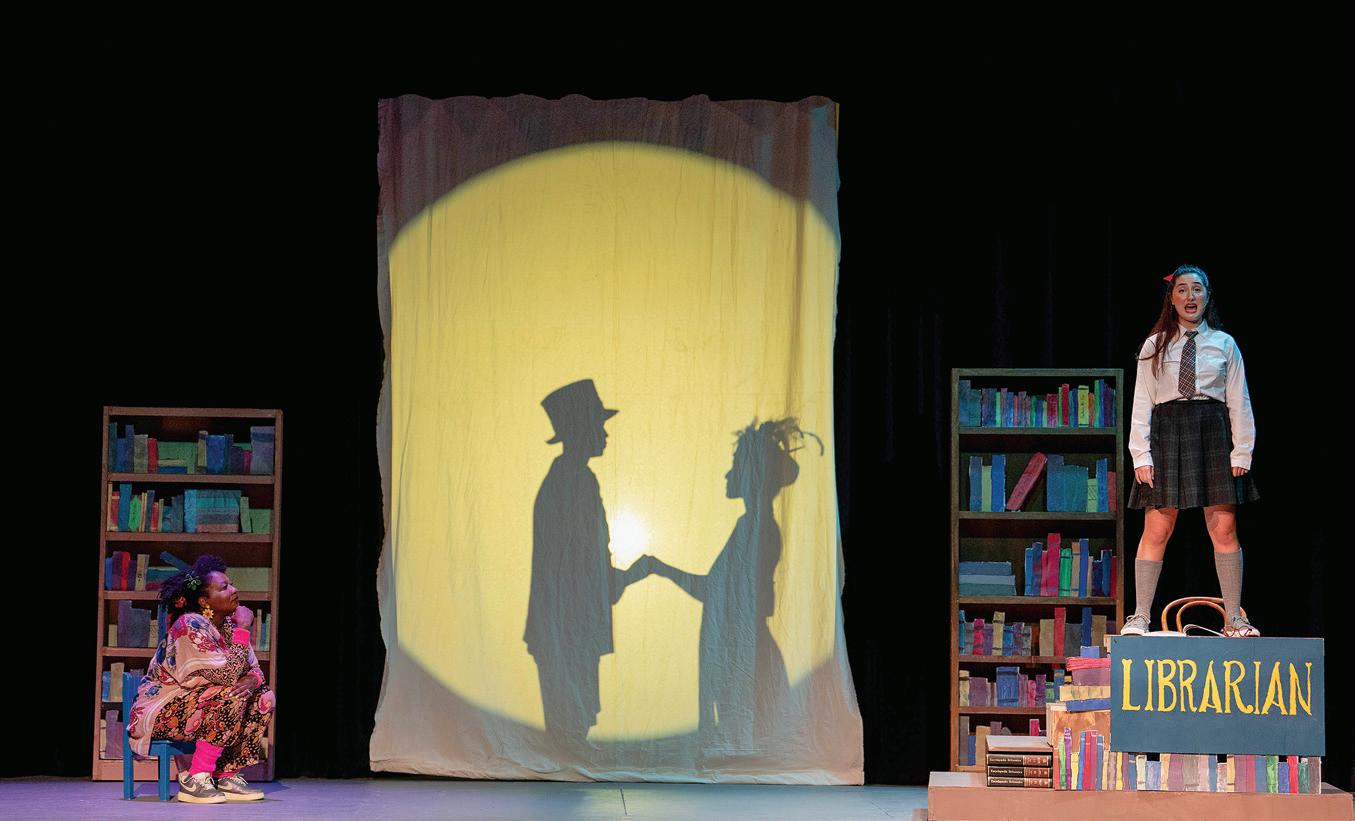




TAFT FACULTY MEMBER AND ARTIST
Kiayani Douglas created five pieces of art included in the book, Frankenstein Art Novel She was one of 12 fine artists representing a range of mediums who contributed a total of 66 bespoke artworks to the Frankenstein Art Novel collection. All of the works were created in response to Frankenstein (1818) by Mary Shelley, and offer “a contemporary examination of humankind’s quest for knowledge, the role of women, and the hope and rage of society’s most ostracized.”
“The monster in the book Frankenstein was desperate to have his own family and be ‘free,’” says Douglas. “One of the pieces I created for the book is Elizabeth Douglas from Saint Kitts
and Nevis. She was promised her freedom upon her enslavers’ death, but had to fight through court systems to gain that freedom for herself and her two boys decades later.”
Douglas was also part of a panel discussion at The Grolier Club, New York, celebrating the release of the book.
Douglas received her BFA in ceramics and an interdisciplinary MFA from The Hartford Art School. She studied across the Americas including El Salvador, Oakland, California, and Miami, Florida, with unique faculty including curator Nico Wheadon, and artists Mary Mattingly, Mark Dion, and Christy Gast. As an interdisciplinary portrait artist, Douglas uses her art to engage individuals in important conversations around race, history, and privilege. She has recently restored the oldest mural in Springfield, Massachusetts, originally painted by artist Donald Blanton in the late ’60s as a part of the Afro Cobra movement. B
 Left: Portrait of Elizabeth Douglas from Frankenstein Art Novel, by Kiayani Douglas.
Left: Portrait of Elizabeth Douglas from Frankenstein Art Novel, by Kiayani Douglas.



STUDENT CHOREOGRAPHERS AND DANCERS EXPLORED THEMES OF FRIENDSHIP, PERSONAL GROWTH, BEAUTY IN ALL STAGES OF LIFE, EMPATHY, THE EMPOWERMENT AND INNATE FEMININITY OF BARBIE, AND MORE THOUGH MOVEMENT, MUSIC, LIGHTS, AND VIDEO DURING THE ANNUAL END-OF-TERM DANCE SHOWCASE. THE PERFORMANCES SPANNED A WIDE RANGE OF DANCE GENRES, EACH REFLECTING THE DEEP TALENT, PASSION, PERSONAL INSIGHTS, EMOTIONS, AND OBJECTIVES OF THE INDIVIDUAL CHOREOGRAPHERS AND DANCERS. THE FINAL PIECE WAS CHOREOGRAPHED BY DANCE TEACHER AND ARTS DEPARTMENT HEAD SARAH SURBER AND HER DANCE FOR EVERYONE INTRO CLASS. BRAVO!
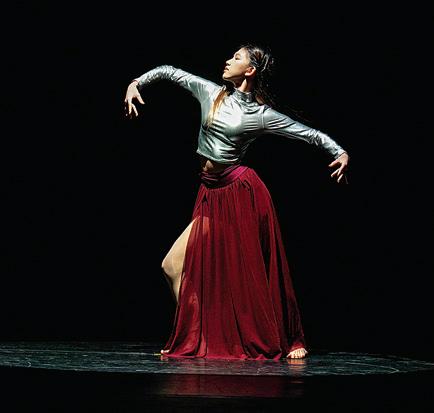



Advanced and Intermediate Dance students studied hip-hop with guest educator and choreographer Caitlyn Hydeck. The fruits of their work were incorporated into some performance pieces during Taft’s annual Fall Dance Showcase.
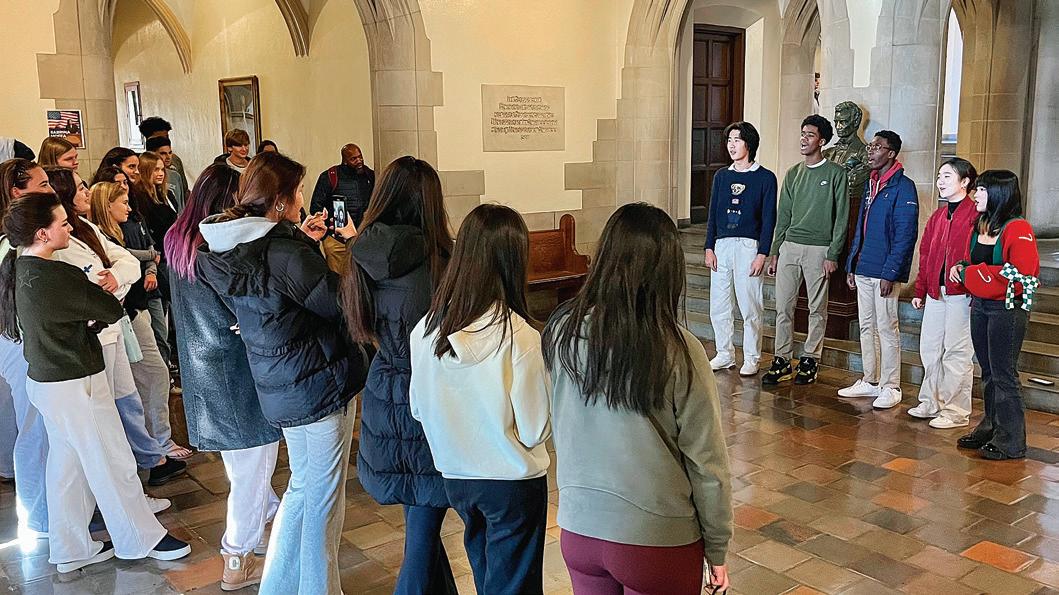
Oriocos, Hydrox, and now, Miredos!
Taft’s new coed a cappella group made its debut in Lincoln Lobby. Miredos’s exceedingly talented members are, from left, Steven Zhang
’26, Jabari King ’26, Isaac Obeng ’26, Hannah Xu ’26, Maya Takanabe ’26. PHOTO COURTESY BRUCE FIFER

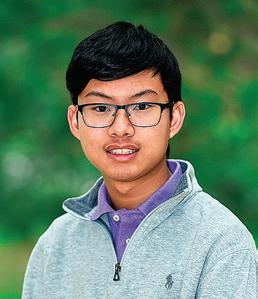

Through a competitive audition process, Taft artists Matt Romero ’25, Maddie Hsu ’25, Steven Zhang ’26, and Eden Thompson ’26 were chosen to perform at the 2024 Connecticut Northern Regional Music Festival. The Festival, sponsored by the Connecticut Music Educators Association (CMEA), was held in January. The CMEA Festival tradition dates back to 1936.

Students in Ms. Surber’s Intermediate and Advanced Dance classes attended the annual New England Prep School Dance Festival at Ethel Walker School. They participated in master classes in various styles of dance, and shared a performance with dancers from Walker, Miss Porter’s, Loomis Chaffee, and Northfield Mount Hermon.
 PHOTO COURTESY SARAH SURBER PHOTO COURTESY
PHOTO COURTESY SARAH SURBER PHOTO COURTESY


IN RECOGNITION OF HIS STEADFAST loyalty and dedication to Taft, John Dayton ’64 will be honored with the 2024 Horace Dutton Taft Alumni Medal. The Medal is given each year to a person whose life work best reflects the essence of the Taft School motto: Non ut sibi ministretur sed ut ministret; Not to be served but to serve.
“John Dayton ’64 exemplifies our school’s motto, Not to be served but to serve, in
multiple ways,” said John Merrow II ’59, chair of the Horace Dutton Taft Alumni Medal Committee. “Throughout his life, John has given back, serving his community, his country, and his school. Taft has many outstanding graduates who are deserving of the school’s highest honor, the Horace Dutton Taft Alumni Medal, but none more worthy than John Dayton.”
After graduating from Taft in 1964,
Dayton returned to his home state of Minnesota to attend the University of Minnesota at Morris. He graduated with a double major in English and speech and then joined the university’s staff, serving as the assistant director of admissions and teaching undergraduate speech. His teaching career was interrupted in 1969 by two years of service in the military. With his military commitment completed, Dayton returned to
his position at the University of Minnesota and then matriculated at the Texas Tech University School of Law in Lubbock, where he was a distinguished scholar, serving as an editor of the law review and graduating third in his law school class.
Following law school graduation, Dayton remained in Texas, joining the Dallas firm of Thompson, Knight, Simmons & Bullion, where he specialized in real estate law. After nearly a decade of active practice, he resigned from the firm and entered the restaurant business, opening Routh Street Cafe in Dallas. The restaurant’s five-star rating consistently kept it on the list of the nation’s premier restaurants. Dayton followed the success of his first restaurant with others: Baby Routh in Dallas and Goodfellow’s and Tejas in Minneapolis, consistently recognized among the Twin Cities’ premier dining establishments. He also opened a wholesale bakery and a hospitality consulting firm in Minneapolis.
Dayton has been a devoted champion of the arts, serving as chair of the Dallas Center for the Performing Arts and chair and president of the board of the Dallas Opera, as well as on the boards of the Minnesota Orchestra, the Dallas Museum of Art, the Dallas Symphony, Bravo Vail, and the advisory boards of the Nasher Sculpture Center and Minnesota’s Walker Art Center. He was recognized for his extensive support of the arts in Dallas with the Neiman Marcus Silver Cup Award, bestowed annually upon one man and one woman “who believe in the power and beauty of art and have given selflessly to promote the excellence and accessibility of the arts in the Dallas community.”
Dayton is the immediate past-chair of Defenders of Wildlife, a national conservation organization dedicated to the protection and restoration of imperiled species and their habitats throughout North America. He also has served as chair of the Dallas County Youth Village, a residential treatment facility for juvenile offenders; as an executive committee member of the Dallas Zoological Society; and as a board member of ChildCare Dallas. He is on
the advisory board of the Texas Women’s Foundation and is a trustee emeritus of the University of Minnesota Foundation. He has been a trustee of the Hockaday School, the Eaglebrook School, and Taft, where he was a member of the board for 25 years.
In 2008, Dayton and his late wife, Arlene, were recognized with the Dallas Historical Society Award for Excellence in Community Service. In 2009, the couple was jointly awarded the Dallas Contemporary Legends Award for philanthropic service.
Widowed in 2017, Dayton has two grown children who are Taft graduates, Chad ’93 and Whitney ’97.
“John is a true embodiment of dedication to community,” said Head of School Peter Becker ’95. “His contributions to
Students from Taft’s JV squash team and theater program traveled to Waterbury to share their time and talents with students enrolled in afterschool programming at the Rivera Memorial Foundation, which offers reading assistance, skill-building, health and safety workshops, nutrition education, and more. In between academic prep and homework help, the group found time for a rousing game of dodgeball.
the arts reveal his deep appreciation for and dedication to cultural enrichment. John’s philanthropic endeavors—serving on various boards, including several private schools as well as Taft—reflect his commitment to positively impacting people. We are so grateful for his years of service on Taft’s board of trustees and for his contributions in chairing the board’s admissions committee. Cheers to John—he is a true champion of the arts and a beacon of community service!” B
The Horace Dutton Taft Alumni Medal is the school’s highest alumni honor and is given each year to a person whose life work best typifies the school motto: Not to be ministered unto but to minister.
The Horace Dutton Taft Alumni Medal is a reminder of Taft’s commitment to serve others.

 PHOTOS COURTESY HELENA FIFER
PHOTOS COURTESY HELENA FIFER

Taft’s Red Rhino Fund is an endowed charitable fund run by a ninemember student board with faculty advisors. The Fund’s mission is an extension of the school motto, Not to be served but to serve. The group works to create positive change in the Greater Waterbury community for children by awarding monetary grants and promoting local organizations in support of education, literacy, and the arts. Grant dollars come from a variety of events held throughout the school year, including Spring Fling, Denim Day fundraisers, athletic tournaments, and a seasonal favorite the annual Fall Festival (in photo), featuring pumpkin carving, games, cider and donuts, an obstacle course, and more.
It was a command performance as Tafties returned to longtime local service partner Camp Mataucha for an afternoon of service and support. This time, Taft Theater students took center stage on the cleanup work at the camp. Mataucha is a YMCA summer camp serving children from more than a dozen area towns. Their traditional day camp program includes swimming, boating, archery, arts and crafts, group games, low and high ropes, a climbing tower, sports, and a nature program. Mataucha also offers specialty camps focused on fishing, aquatic activities, mountain biking, survival, and performing arts.
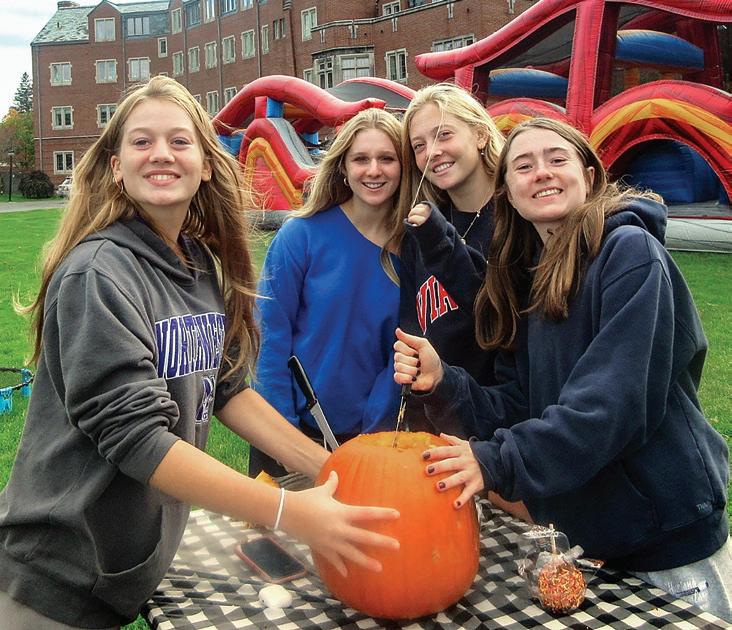
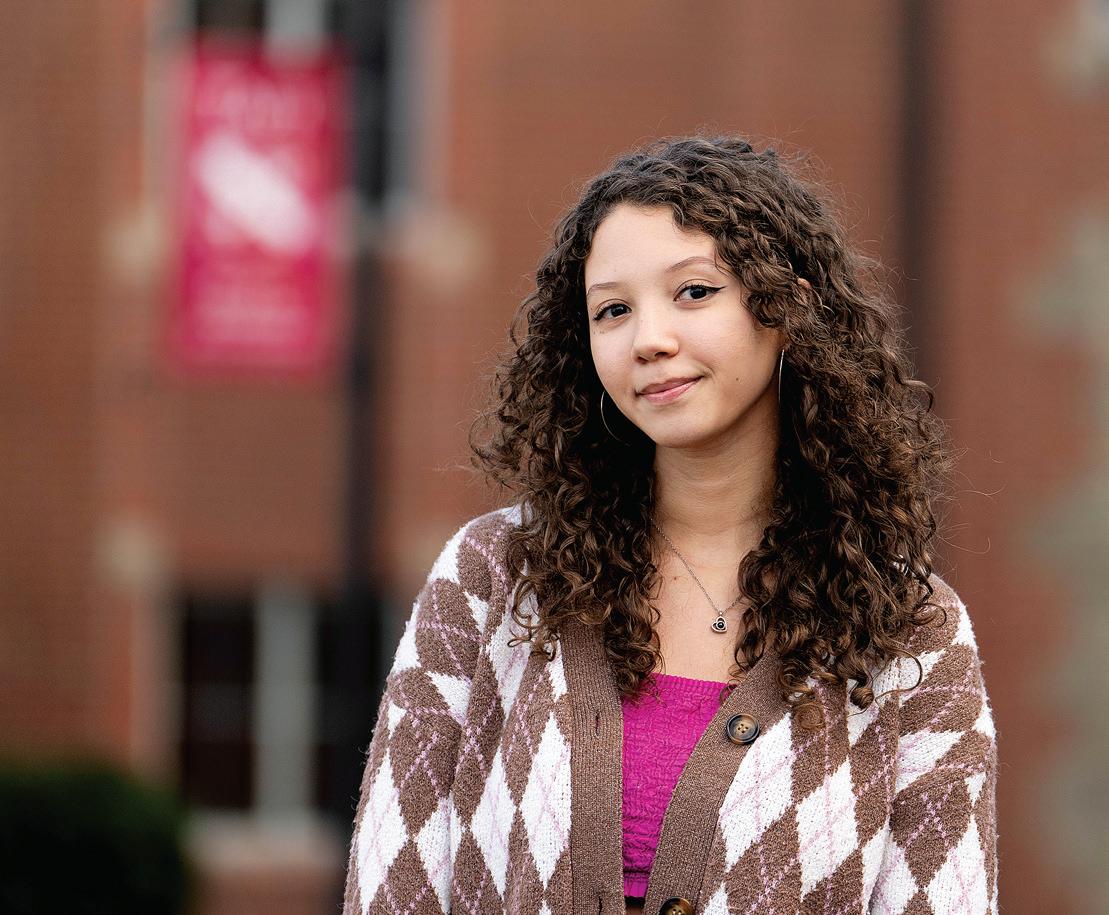
ISABELLA Nascimento Silva Pinto ’25 was recently named a Rise Global Winner. She was one of 100 Global Winners from 43 countries to become part of the newest Rise cohort. Each year, Rise works to identify and recognize “promising young people,” ages 15–17, through an extensive application and review process; fewer than 10% of all applicants are named Global Winners. Founded in 2019, Rise is the flagship program of a $1 billion commitment by Eric and Wendy Schmidt to find and support global talent and encourage service and learning by providing support through four-year scholarships (including a living stipend), career services, and funding opportunities,
including options to apply for seed money and grants for projects, and opportunities to work with other Global Winners. Rise collaborates with more than 60 partners from around the globe to identify and nurture talent from communities worldwide.
In recognizing Isabella as a Global Winner, Rise acknowledged her passion “about the intersections of social justice, art, politics, and youth activism. Raised in a vibrant Brazilian community, she believes in service and collaboration as tools for social improvement.” Rise cites Isabella’s work as head of graphic design at an NGO, her roles as tutor and student leader at Taft, her efforts to introduce low-income Brazilian students to
extracurricular opportunities, and her status as an alumna of Stanford’s Pre-Collegiate Studies and a multi-gold medalist in national Olympiads as predictors of her ability to significantly impact the global community throughout her lifetime as she continues to “leverage her knowledge and learning opportunities to uplift the lives of others.”
Each Rise applicant is required to dedicate themselves to a passion project. Isabella’s project, “Cores do Brasil,” is an organization that supports elevating queer Brazilian individuals through sharing opportunities and fostering community. Isabella hopes to apply her artistic skills to help fight for social causes through visual storytelling and art. B

FOUNDERS LEAGUE CHAMPIONS
NEPSAC CLASS A CHAMPIONS
Field hockey was crowned the NEPSAC Class A champions as they defeated Andover 3–2 in a thrilling back-and-forth game.
Field hockey completed an undefeated season (the first time in school history), going 20–0–1, and winning the NEPSAC Class A championship for the first time since 1999.
Ariana Ftorek ’25 advancing up the field in game action against Andover during the NEPSAC Class A championship game in November.
Photography by Robert Falcetti
IN NOVEMBER, FIELD HOCKEY was crowned the NEPSAC Class A champions as they defeated Andover 3–2 in a thrilling back-and-forth game. The Rhinos found themselves up early, before falling behind 2–1, eventually scoring two more to reclaim the lead, and they never looked back. With the victory, they completed an undefeated season (the first time in school history), going 20–0–1, and winning the NEPSAC Class A championship for the first time since 1999.

15–1–4
FOUNDERS LEAGUE CHAMPIONS
NEPSAC CLASS A FINALISTS
After a fantastic regular season and two great victories in their quarter and semifinal matchups, boys’ soccer earned a spot in the NEPSAC Class A championship game where they faced Milton. They fought hard until the very end, before eventually falling 2–0 to the Mustangs. With this being their only loss of the season, they finished with an overall record of 15–1–4, and as the NEPSAC Class A runner-ups.
Preston Alessio ’25 in game action versus Worcester during the NEPSAC Class A Semifinal game in November.
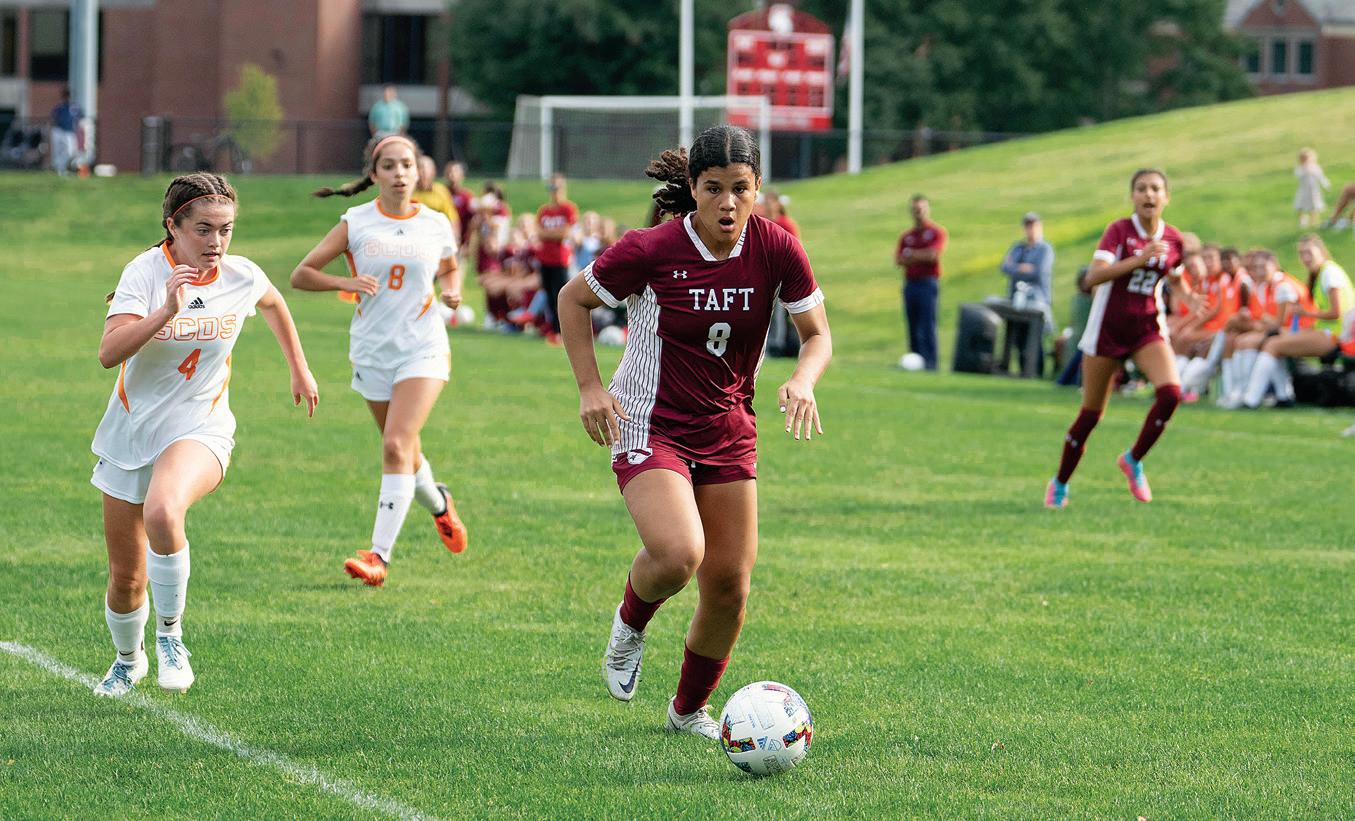
THIRD PLACE, FOUNDERS
LEAGUE TOURNAMENT
NINTH PLACE, NEPSTA
DIVISION I CHAMPIONSHIP
Boys’ cross country rounded out their season with a third-place finish in the Founders League Tournament, before heading to the NEPSTA Division 1 championship, where five out of seven runners finished before the 18-minute mark, and placed ninth overall out of 15 teams.

SECOND PLACE, FOUNDERS
LEAGUE TOURNAMENT
SEVENTH PLACE, NEPSTA
DIVISION I CHAMPIONSHIP
Girls’ cross country ended their season on a high note, finishing second in the Founders League Tournament before competing in the NEPSTA Division 1 championship race held at Loomis, where each varsity runner recorded a personal best time and they finished seventh overall.

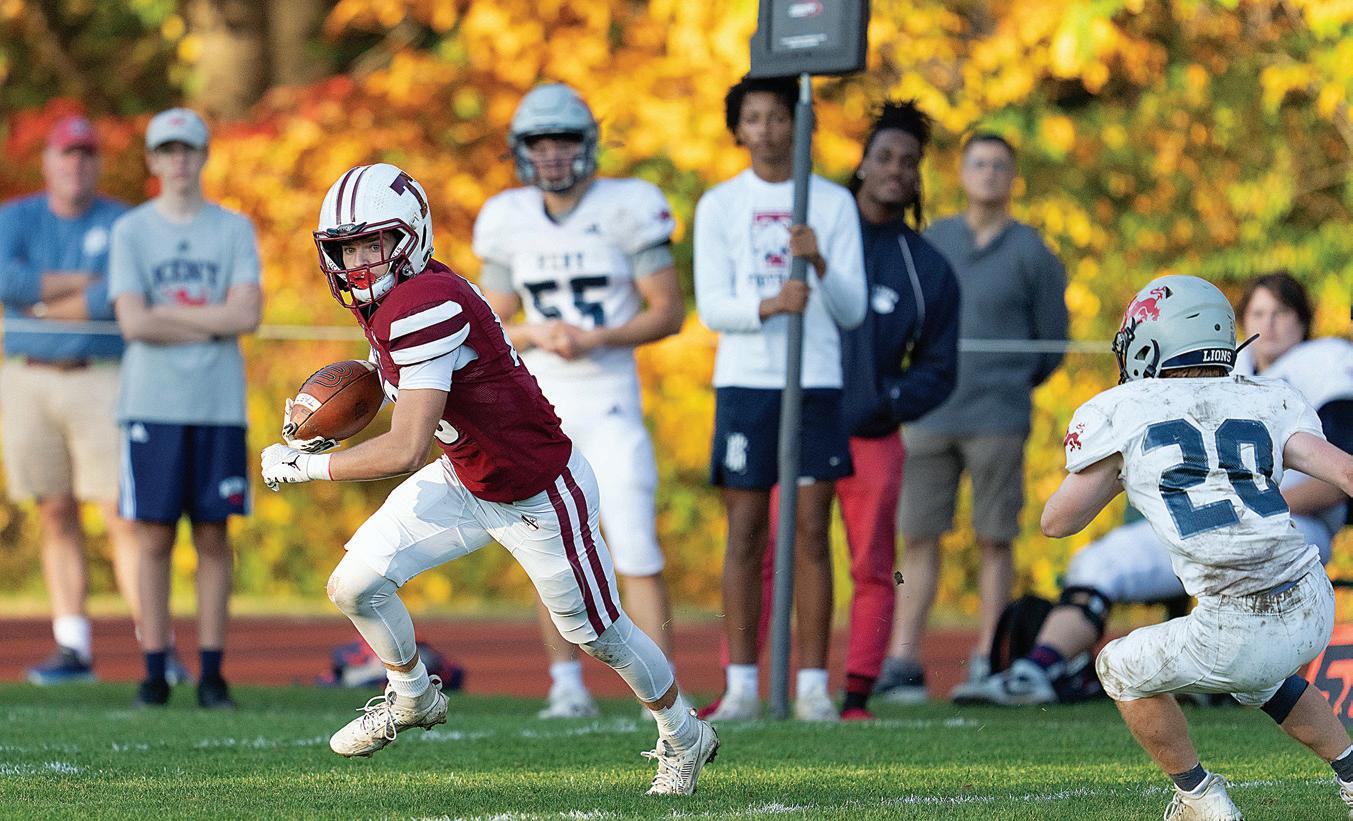
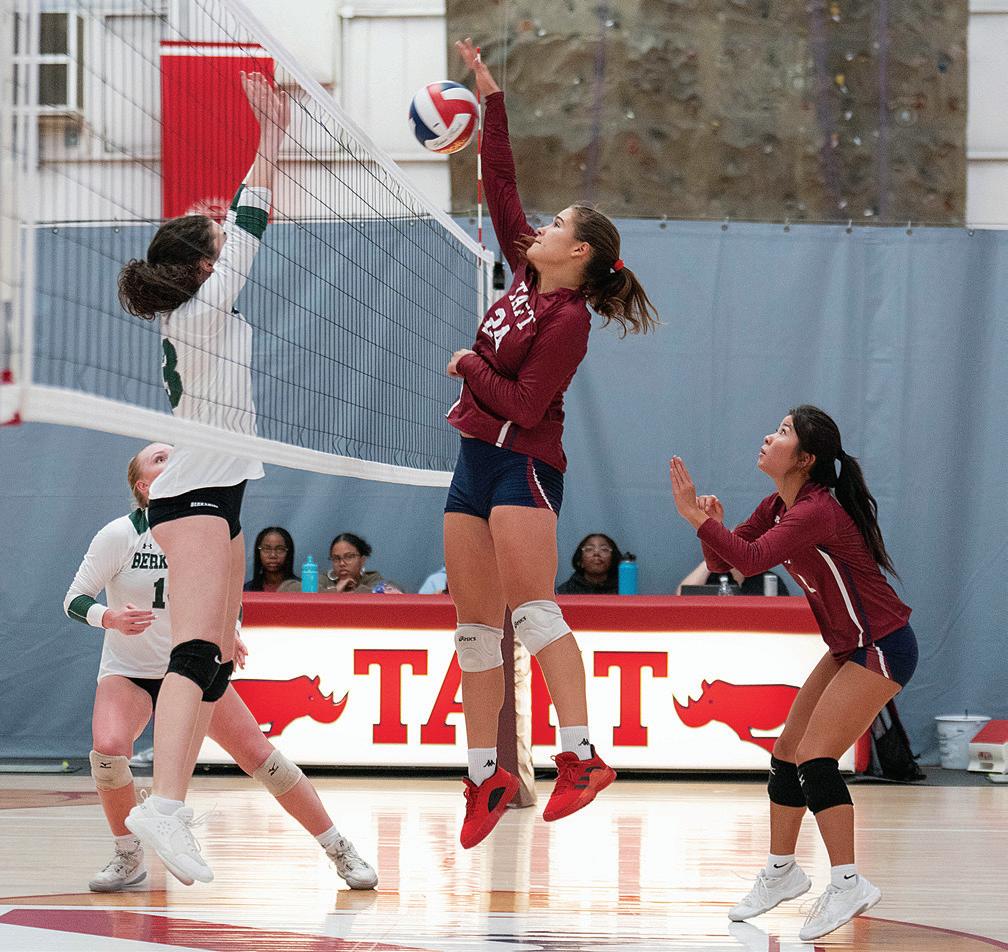
Field Hockey Award—Maisy Ricciardelli ’24
NEPSAC Player of the Year—Maisy Ricciardelli ’24
All-NEPSAC—Truus van Wees ’24, Rachel Turer ’25, Emily Smith ’25
NEPSAC Honorable Mention—Britty Page ’25, Caroline Traina ’26, Devon Watson ’25
Livingston Carroll Soccer Award—Enoch Duodu ’24
All-NEPSAC—Preston Alessio ’25, Henry Bacon ’24, Enoch Duodu ’24
NEPSAC Honorable Mention—Patrick Gallagher ’24, Joaquin Mañon ’25, Marcos Santana ’26
1976 Girls’ Soccer Award—Faith Graziano ’24
John B. Small Boys’ Cross Country Award— Ali Griswold ’24, Trevor Stellmach ’24
All-NEPSAC—Tate Celebi ’25
Girls’ Cross Country Award—Sydney Grogean ’24
All-NEPSAC—Charlotte Murphy ’25
Black Cup Award—Michael Pangaro ’24
Harry K. Cross Football Award—Gunnar Watson ’24
All-NEPSAC—Andre Crews ’24
NEPSAC Honorable Mention—Michael Pangaro ’24
Volleyball Award—Katherine Erbstein ’24, Sara Takanabe ’24
NEPSAC Honorable Mention—Lucy Schwab ’24
Marta Sukovic ’25 looks to finish the point against Berkshire in September.


The energy was high, the determination deep, and the Red Rally message clear: The Rhinos were ready to show the Bearcats how it is done on Hotchkiss Day! In November, the Rhinos traveled to Lakeville for this year’s Hotchkiss Day. Football (24–6) and boys’ soccer (5–0) captured victories, field hockey played to a 1–1 tie, and girls’ soccer (2–0) and volleyball (3–0) were handed losses.
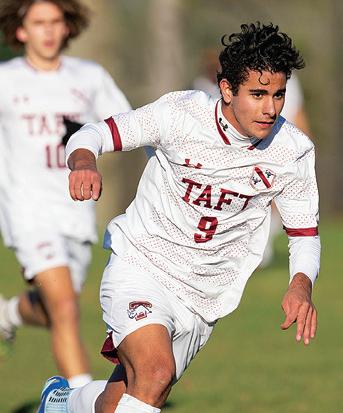

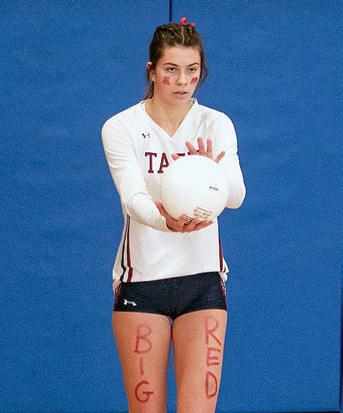


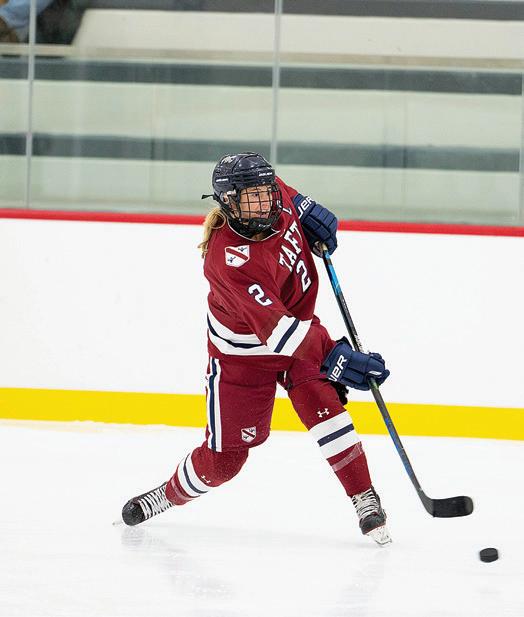
Twenty-six student-athletes (11 in the fall, 15 in the winter) participated in Taft’s first two National Signing Ceremonies for the school year in Bingham Auditorium. The ceremonies celebrated students who made commitments to continue their academic and athletic careers at the college or university level. Coaches, families, teammates, and the full Taft School community were invited to the events.
Congratulations to:
Maisy Ricciardelli ’24, Boston College
Women’s Lacrosse
Truus van Wees ’24, University of Michigan
Bennett Raphalian ’24, Rutgers University
Sam Lovell ’24, United States Air Force Academy
Harry Attell ’24, College of the Holy Cross
Luke Jamin ’24, University of Virginia
Tristan Bach ’24, United States Naval Academy
Pearse MacDonald ’24, University of Pennsylvania
Chris Reinhardt ’24, University of Notre Dame
Jack Elliott ’24, University of Michigan
Quinn Whipple ’24, University of Pennsylvania
THE 40TH ANNUAL PATSY K. ODDEN GIRLS’ INVITATIONAL HOCKEY TOURNAMENT took place on Thursday, December 14 and Friday, December 15. The teams that competed in this year’s tournament were Taft, Choate, Hotchkiss, Kent, Lawrenceville, Loomis Chaffee, Phillips Andover, and Tabor. After two full days of games, Loomis and Andover faced off in the championship game, with Loomis taking home the tournament title.

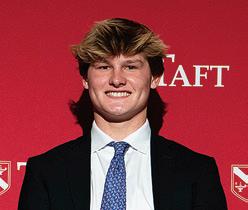
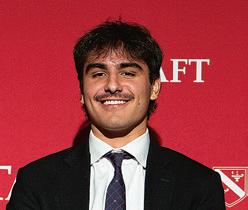
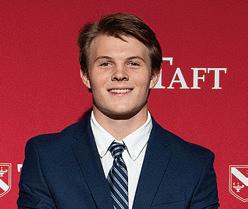
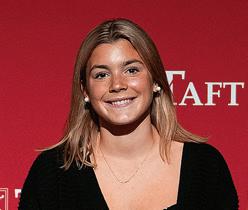


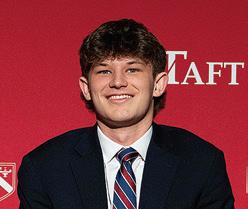

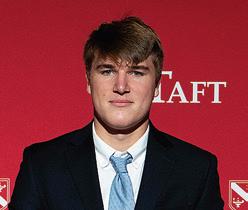


Congratulations to:
Henry Bacon ’24, Babson College
Graham Buchanan ’24, Trinity College
Enoch Duodu ’24, Amherst College
Patrick Gallagher ’24, Wesleyan University
Nolan Jacobi ’24, Wesleyan University
Harry Revenaugh ’24, Middlebury College
Women’s Soccer
Faith Graziano ’24, University of Miami
Men’s Lacrosse
Ben Friedman ’24, Yale University
Teddy Sachs ’24, Trinity College
Matthew Surin ’24, Yale University
Ben Wick ’24, Amherst College Football
Josh Kuczynski ’24, Amherst College
Braden MacDonald ’24, United States Naval Academy
Rostand Olama ’24, Bucknell University
Gunnar Watson ’24, Hamilton College
Since 1964 the National Collegiate Athletic Association (NCAA) has recognized commitments between student athletes and Division I and II athletics programs through their National Letter of Intent (NLI) program. The program now includes 676 Division I and II participating institutions.

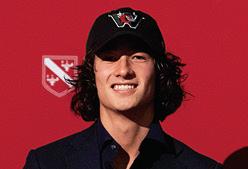

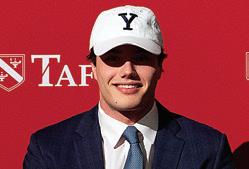
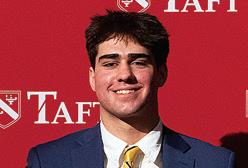
IN EARLY DECEMBER, BOYS’ VARSITY
HOCKEY fell to the Berkshire Bears 4–3 in the annual Lucille A. D’Arco Cup. Lucille was a passionate fan and supporter of both schools: Her son, Brad ’99, captained the Taft team as a student, then went on to coach the Berkshire team after college. In 2008, Lucille lost a courageous battle with breast cancer. Since then, the two schools have honored her legacy on the ice in a game dedicated to her memory, to raising funds and awareness around breast cancer, and to commemorate the D’Arco family’s involvement with and love for both institutions. B

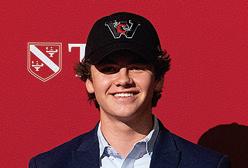





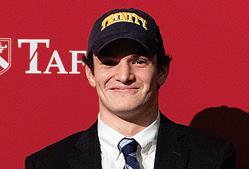


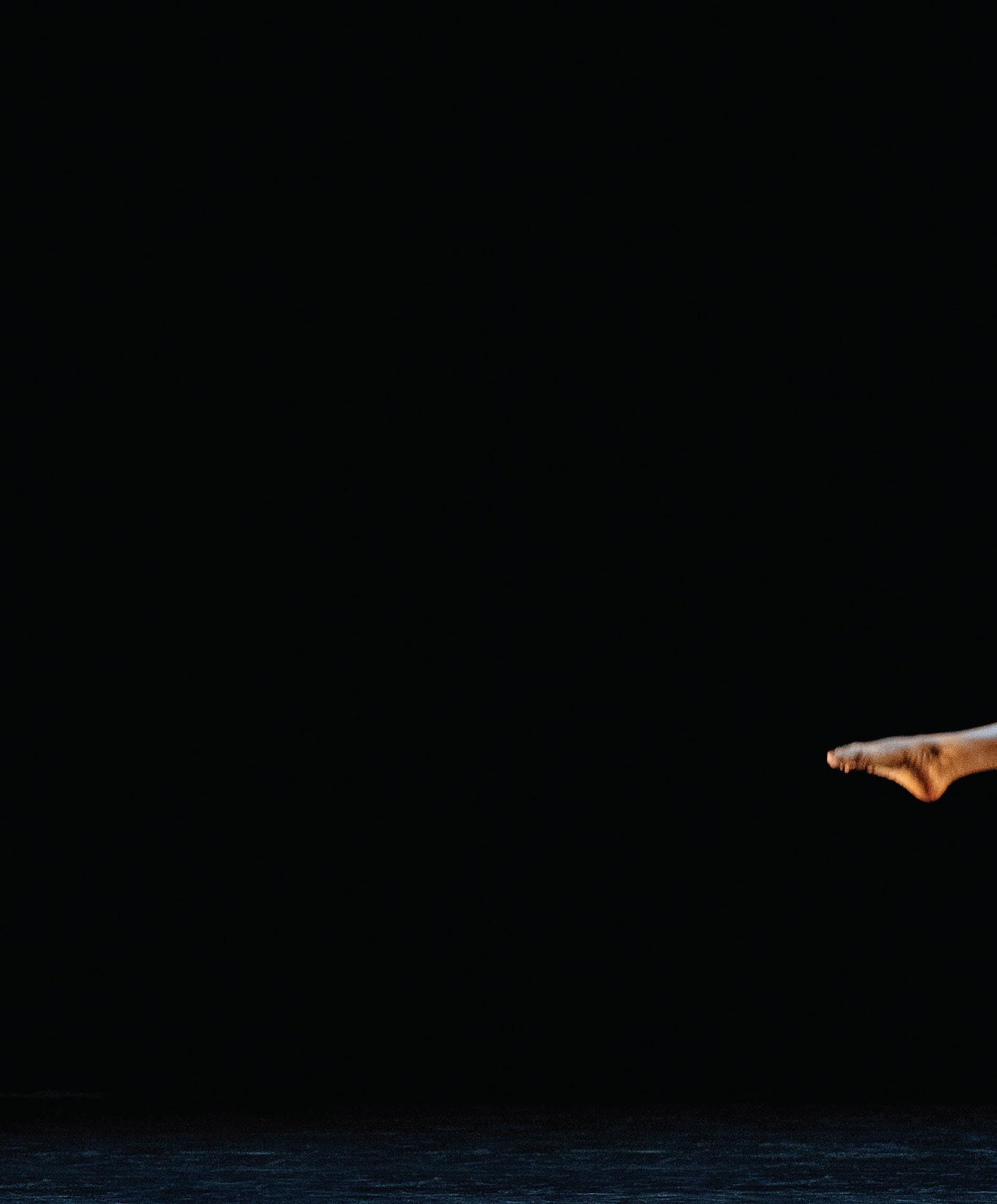

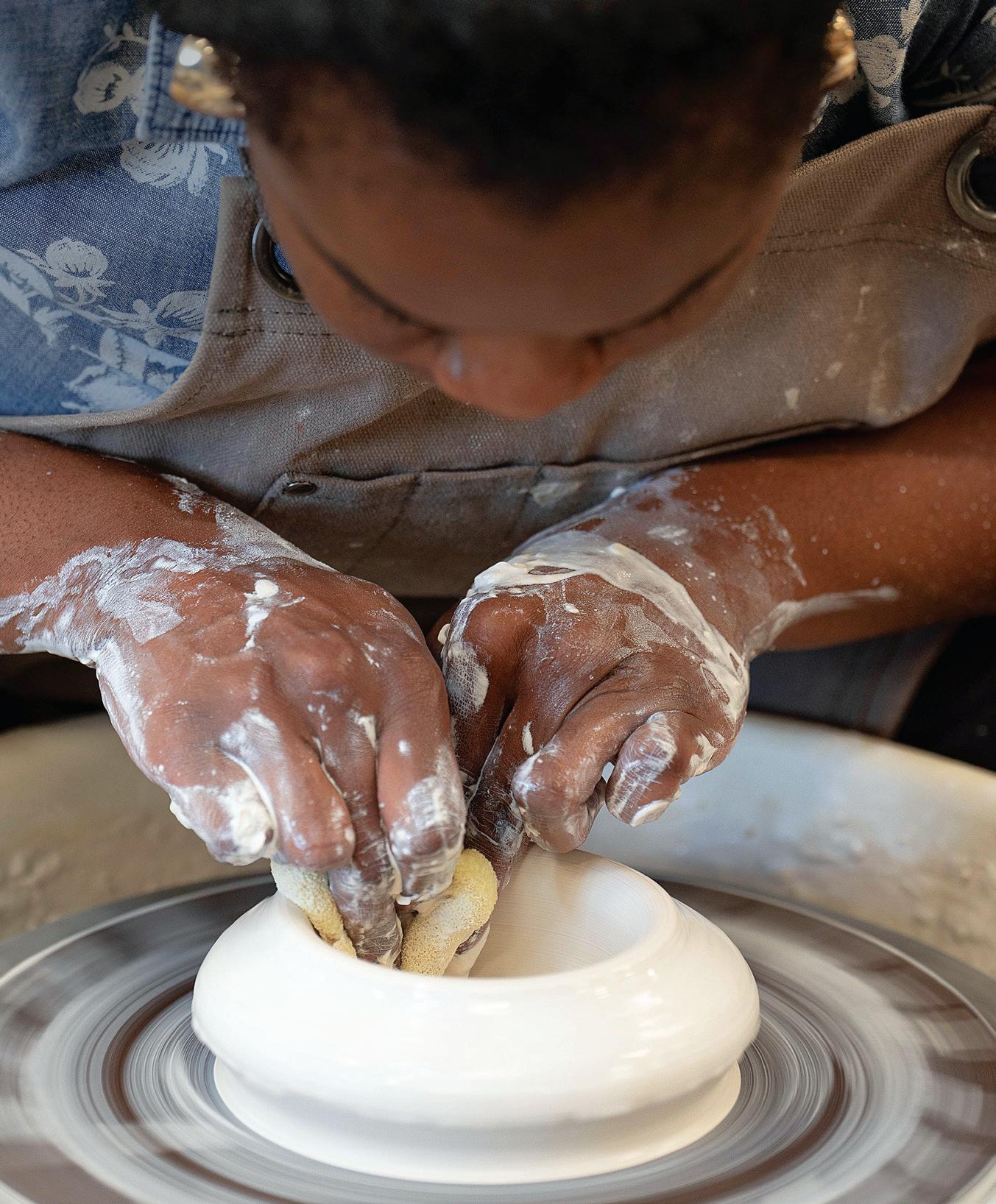
ART IS THE MOST ELEMENTAL FORM OF EXPRESSION. IT CHALLENGES THE MIND, FILLS UP THE SOUL, AND INSPIRES INNOVATION. IT IS ROOTED IN IMAGINATION, SHAPED BY CREATIVITY, AND NURTURED BY PASSION. IT IS TACTILE, CEREBRAL, PHYSICAL, AND EMOTIVE.
ORIGINAL —something that they alone envisioned, cultivated, and followed through to completion,” says Taft Arts Department Head and Dance Teacher Sarah Surber. “The idea of moving something from concept to process to product to pride in achievement stays with students who study the arts as they enter the world outside of Taft—in college, in careers, and in parenthood—and helps them find success in those spaces.”
Embracing the consequential nature of arts in education is part of Taft’s history: The school’s foundational mission to educate the whole student acknowledges the vital role art plays in shaping the spirit, intellect, and lives of Taft students and alumni. Now, more than 130 years after the school’s founding, Taft students are required to take at least one semester of art in each academic year. In doing so, they choose from nearly 50 classes encompassing music, fine arts, performing arts, and film; they may also choose from a range of Afternoon Program arts offerings, clubs, programs, and activities. Along the way, they learn from a dozen arts faculty members, most with advanced degrees, and almost all, Surber notes, “active artists, practicing their craft and leading by example.”
Kiayani Douglas earned a B.F.A. in ceramics and an interdisciplinary M.F.A. from the Hartford Art School. As an interdisciplinary portrait artist, Douglas uses her art to engage individuals in important conversations around social justice narratives. She was one of 12 artists chosen to create bespoke artwork for the Frankenstein Art Novel, a contemporary exploration of the 1818 Mary Shelley novel with an emphasis on nature and feminine power. Douglas also recently restored the oldest mural in Springfield, Massachusetts, originally painted by artist Donald Blanton in the late 1960s. She continues to show her work in galleries across the region.

“I became a ceramics major because I realized the limitless opportunities for connection to science and math that I could have while still making beautiful things,” says Douglas. “As a practicing artist outside of school, it is really important to me to show how art shows up in real life and how those critical thinking aspects are ways for us to really challenge what we know and what we understand.”

“They are passionate about their mediums and committed to training and inspiring high-level students to go deeper into self-discovery and innovation, while offering new artists a window into all of the ways art can enrich their lives,” says Surber. “Each faculty member also works to bridge the gap between the emerging artists and those creating at a higher level by building programs that allow for progression, creating space for students to grow from foundational levels into mature, confident, accomplished young artists.”
Arts Department Head and Dance Teacher Sarah Surber on stage at Taft with Tandem, the resident dance company at Moving Arts Exchange (MAX), a nonprofit dance organization based in Great Barrington, Massachusetts. Surber notes that most members of the arts faculty are “active artists practicing their craft and leading by example.”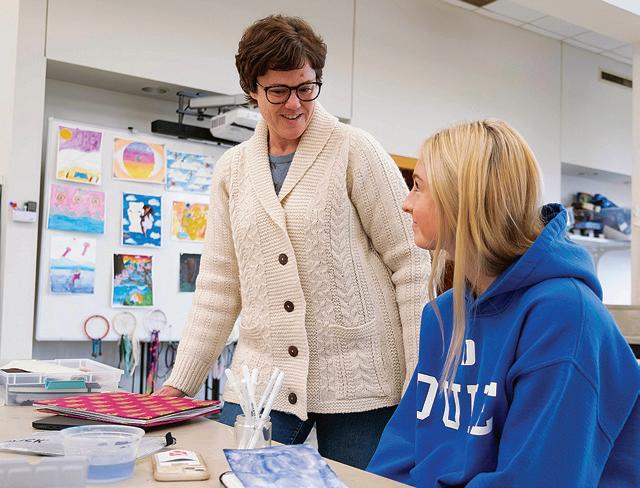

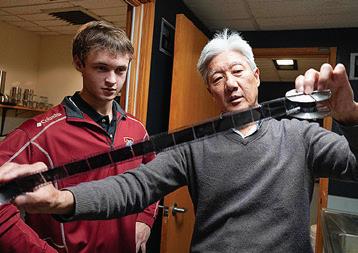
YEE-FUN YIN. His introductory level photography classes are “totally analog and hands-on,” with a focus on 35mm manual mode settings and shooting with black-and-white film, which students also learn to develop. In the more advanced classes, they use that technical knowledge base to explore and experiment, ultimately identifying preferred equipment and mediums while building a creative body of work.
“Images are intentional and consequential, and this is what I want my students to learn,” Yin explains. “All of this is to get students to a point of visual literacy.”
And while applied visual literacy elevates the photographic work produced by Yin’s students, it also enhances and advances actualized learning across the visual arts curriculum.

Visual literacy, at its core, is the ability to read, write, and create visual images. Fluency brings an understanding of things like angles and perspectives, layout and composition, light, color, and framing. Meghan Balliett and John O’Reilly teach a range of fine arts courses that both develop and employ this fluency, including from Art and the Natural World and Drawing and Design, to Intermediate Painting and Drawing, 3D Design, and Advanced Studio Art.
“Art allows students to become strong visual thinkers,” says Balliett. “It helps them develop their imaginations and problem-solving skills, and to explore new ways of thinking and seeing the world.”
Yee-Fun Yin PHOTOGRAPHY Meghan Balliett FINE ARTS AT TAFT
My projects and assignments are designed to help students see their true potential, and build a really strong visual arts foundation.”
John O’Reilly

Like Yin’s photography students, Heather Dawson’s film students create new worlds through the lens of a camera. An Emmy Award-winning director and producer, Dawson has been a visual storyteller for more than 20 years. She shares her knowledge and experience with students through The Art of Visual Storytelling, Digital Film Production, and Advanced Filmmaking classes. By immersing themselves in worlds imagined by some of American cinema’s best filmmakers, Dawson’s students first learn to “read” a film. They study tools and technique, scriptwriting, storyboarding, and film editing. More advanced students form an on-campus production company and work collaboratively to create high-quality documentary and narrative short films.
“There is such power in the art of visual storytelling that really has the ability to inspire us and teach us and show us different perspectives,” Dawson notes. “Studies have shown that by watching films, we gain a deeper sense of empathy, and I think that’s really important to teach our students.”
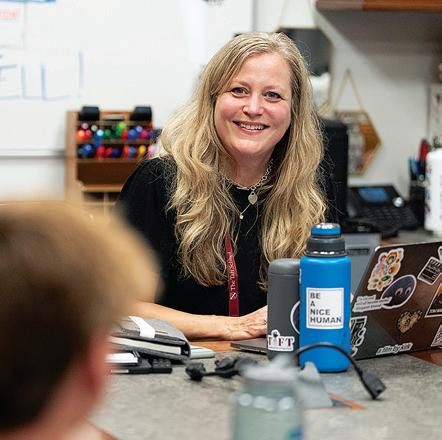
 Right: Heather Dawson and her film students “on set” in the Faculty Room.
Right: Heather Dawson and her film students “on set” in the Faculty Room.
There is such power in the art of visual storytelling that really has the ability to inspire us and teach us and show us different perspectives. Studies have shown that by watching films, we gain a deeper sense of empathy, and I think that’s really important to teach our students.”
Heather Dawson
“My own journey with art history began when I was a high school student in Ralph Nordland’s class,” recalls Art History Teacher Alex Werrell. “He would turn off the lights and the hum of the great machine that he called the ‘dinosaur’ would start. Marvelous images would flash on the board, and we’d be transported through history to a different world—to the Renaissance era in Florence, to Ancient Rome, to the Revolutionary War in America. Every day was a new adventure.”
And a new feeling. Werrell closes his eyes as he shares his memory of Mr. Nordland’s class. It is clear that in his mind, he is back in his high school classroom. He is smiling; his body language is softer. Art is technical. It is also emotional.
“What I hope students can bring out of art history is not just expressionism, so to speak—not just the ability to speak about art, to analyze art, to look at the world around them and draw conclusions from it—but also impressionism. I also want them to take art personally. I want them to be able to look at a piece on a wall that they haven’t seen before and to feel immersed in the art. To feel informed by it and to feel some part of them speaking to it. There’s a reason why we escape to galleries, and it is not just to lose ourselves in the rhythm of the day; it’s also to immerse ourselves in the world of art where you can look around and just feel.”
 Alex Werrell ART HISTORY
Alex Werrell ART HISTORY

Theater production is a style of teamwork that is not a sport—there are no points scored, there are no goals—but everyone works together to ensure the success of the play and players.”
Rob Dawson
It is something Acting and Public Speaking Teacher
Helena Fifer thinks about, as well.
“In my public speaking class, I encourage kids to share their own stories—to make connections with the audience through personal stories that are both genuine and specific, Fifer explains. “What I notice happens after the first couple of weeks is that kids really bond with each other. They really support each other and encourage each other to take risks in the class. It is an approach that teaches and fosters empathy.”
Fifer’s public speaking and acting classes allow students to develop practical skills to carry into any classroom, boardroom,
The cast of The Addams Family on stage in Bingham Auditorium. Helena Fiferand, of course, any stage. In her 27 years at Taft, Fifer has directed and produced an impressive catalog of plays and musicals for the Bingham and Black Box theaters. There have been rousing musicals, poignant plays, comedic romps, and works with powerful messages, including last spring’s Cabaret It was the production of The Addams Family, though, that seemed to stand out for its extraordinary artistic achievement. The cast itself was deeply talented. Jawdropping sets, choreography, music, lights and sound, hair and makeup, staging, and props came together to produce what can only be described as theater magic. Taft’s academic arts courses—including those in stagecraft, theater technology, and design— prepare students technically for such an
achievement; working on live productions allows them to turn theory into practice.
“Technical theater gives students the opportunity to do things they wouldn’t normally do to be creative: to paint, and not in a creative way; to build; to problem solve; to explore new avenues in a different format and in an environment they might not have thought of as being a problem-solving or creative space,” says Technical Theater Director Rob Dawson. “Theater production is a style of teamwork that is not a sport—there are no points scored, there are no goals—but everyone works together to ensure the success of the play and players.”
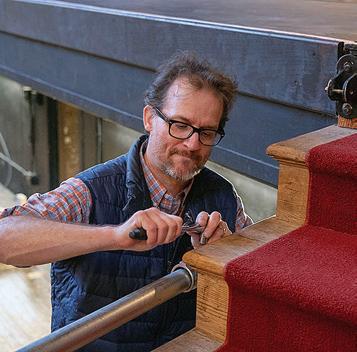

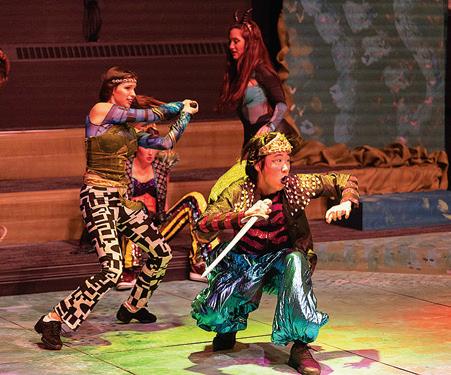
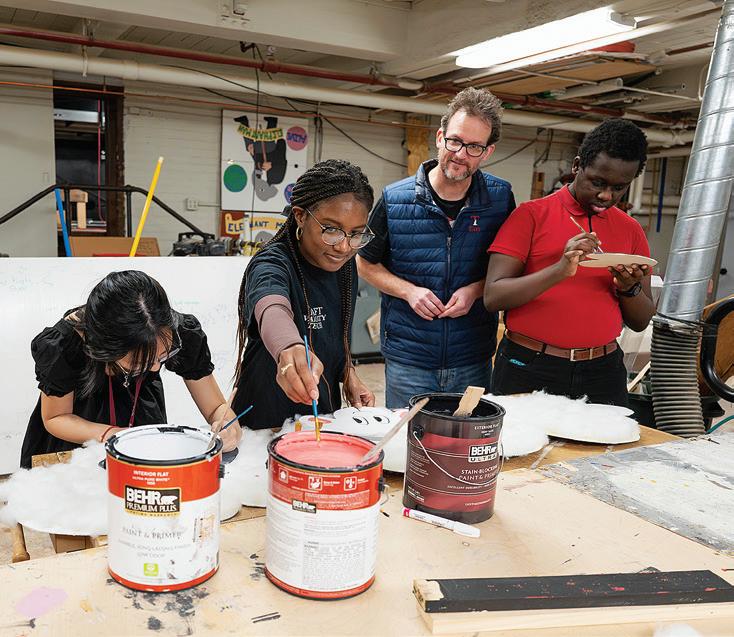 The theater tech team building and painting sets in the scene shop.
She Kills Monsters, staged in the Woodward Black Box Theater. The actors received twiceweekly formal training in stage combat and fight choreography for this production.
Rob Dawson
THEATER TECH
CJ Silverman THEATER TECH
The theater tech team building and painting sets in the scene shop.
She Kills Monsters, staged in the Woodward Black Box Theater. The actors received twiceweekly formal training in stage combat and fight choreography for this production.
Rob Dawson
THEATER TECH
CJ Silverman THEATER TECH
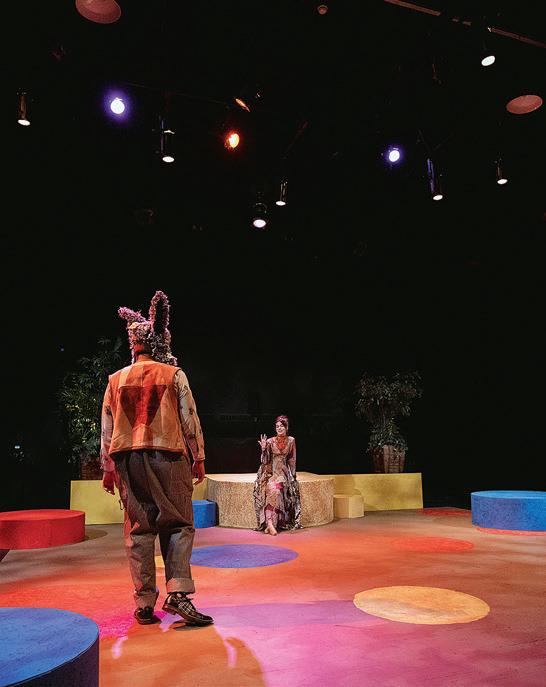
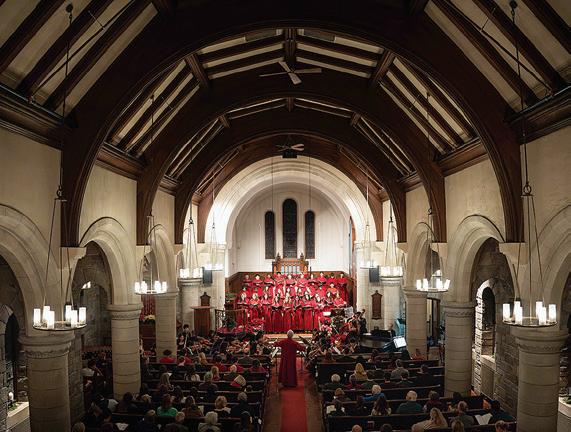
From Main Hall and the Arts and Humanities wing, to Taft’s properties on The Green and DeForest Street, arts spaces dot the extended Taft campus. Main Hall venues begin with Bingham Auditorium on one end; the Choral Room, Lincoln Lobby (a sweet spot for a cappella sound), and Mark W. Potter Gallery line the pathway to the Arts wing. The wing begins at the Main Hall intersection connecting CPT and HDT Halls. To the right and in a multilevel space live the Woodward “Black Box” Theater, a video production classroom, the Pailey Dance Studio, the Gail Wynne Sculpture and Ceramics Studio, the digital recording studio in The Bristol Music Room, photography darkrooms, a digital design lab, and a number of music class and practice rooms, some equipped with pianos. Skip the right-hand turn, proceed down Main Hall toward the dining halls, and climb a flight of stairs to find the Tremaine Art Studio, home to Taft’s painting, drawing, and design classes. Most of the spaces get the job done well; many are beginning to show their age. Relatively recent upgrades to Bingham and Black Box have been a boon to those broadly used spaces.
“Our studios are active and vibrant, and provide a comfortable and essential space on campus for our students to feel relaxed and at home so that they can be free to be creative, innovative, and vulnerable,” notes Arts Department Head Sarah Surber. “Ideally and perhaps in the future, those studios and spaces will be in closer proximity to one another so that all of the amazing things happening in our individual studios can be shared with each other, seen by each other, and maybe even inspire each other to explore new mediums at new levels of creativity so that we are feeding the artistic life at Taft together, as one. This would allow the artists on campus to collaborate more fully and feel a sense of community within the arts.”
Left: A Midsummer Night’s Dream in the Woodward Black Box Theater. Above: Located across from Taft’s main campus, Woodward Chapel is the performance home of the school’s showcase choir.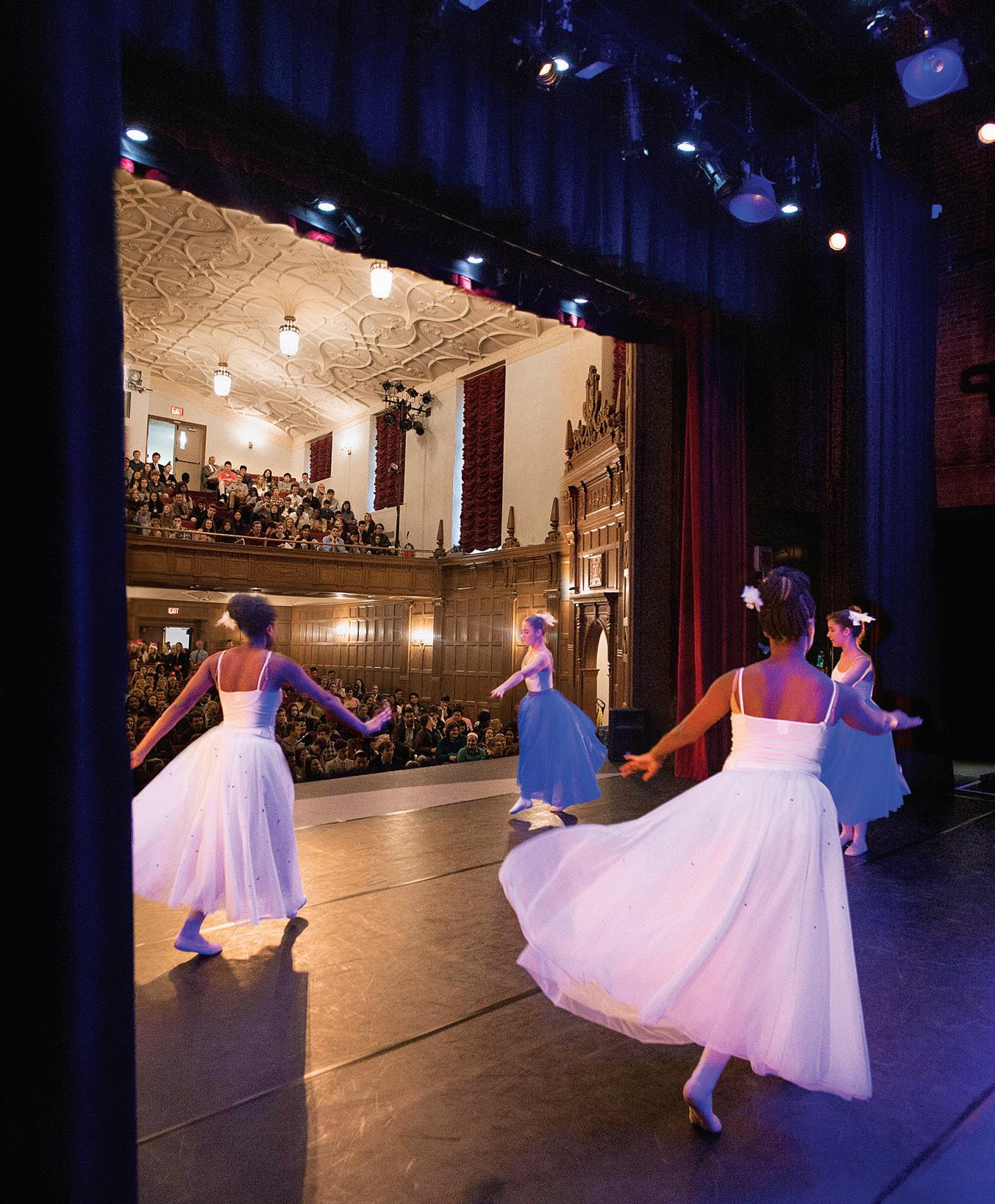
SCAN THIS QR CODE TO LEARN MORE ABOUT ARTS SPACES AT TAFT.

DAWSON SPEAKS OF ARE A PRODIGIOUS GROUP OF TALENTED STUDENT ARTISTS, TEACHERS, AND ARTS PROFESSIONALS.

Each brings something extraordinarily unique yet wholly synergetic to the process. And each stands alone as an artist outside of the theater. The body of work—the training and experience—of a Taft musician or dancer is far greater than the pieces they lend to the stage.
T.J. Thompson’s instrumental music teachings include jazz, classical, improvisation, and electronic music in Taft’s Musical Instrument Digital Interface (MIDI) Lab.
To be part of a group doing many different things in harmony gives me a lot of optimism. To paraphrase my teachers and some of my inspirations, the more collaborative the music is, the more powerful and transformative it can be.”
T.J. Thompson Above: Taft’s Chamber Ensemble performing in Walker Hall.
Above: Taft’s Chamber Ensemble performing in Walker Hall.
On campus, his students perform in formal concerts, accompany Taft theater and Collegium Musicum, and host informal performances in the Jig and on the Jig Patio. In the community, they have accompanied performances at a local opera house, sermons at local churches, joined parades, and performed with Thompson’s professional trio. They audition for and earn spots in music competitions. They have played Carnegie Hall, toured the Czech Republic, Prague, and Texas. And, as often as they can, they spend spring break learning and performing in New Orleans, taking the stage in the French Quarter’s historic Preservation Hall.
“Collaborating with musicians across the globe gets our students thinking about why they play music, how they enjoy music, and why they enjoy playing music with one another,” says Thompson. “To be part of a group doing many different things in harmony gives me a lot of optimism. To paraphrase my teachers and some of my inspirations, the more collaborative the music is, the more powerful and transformative it can be.”
Directed by Bruce Fifer, Taft’s Collegium Musicum is a study in collaboration. Members of the showcase choir breathe

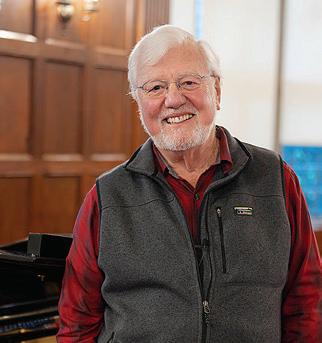

new life into classical masterworks. Collegium members also perform at Taft and around the world. They were the core vocal ensemble in an artistic residency program in Faicchio, Italy, and have performed in Austria, China, the Czech Republic, France, Great Britain, Italy, and Spain. Domestically, their concert tours have taken them coast to coast.
“Every time I stand up and connect with them in a performance, I’m actually looking at them and communicating with them, getting into their soul, and they’re getting into mine—there’s a magic that happens,” says Fifer.
There are opportunities for vocal music study, lessons, and performance at every level at Taft. From Canto and Honors Music Theory to a cappella groups, theater roles, Taft’s professional recording studio, the annual multicultural arts celebration, and coffeehouses, Taft vocal artists fill Taft’s halls with a joyful expression.
Above: Taft’s showcase choir, Collegium Musicum. Below: Onstage performers in Cabaret included musicians from Taft’s jazz and chamber programs. Bruce Fifer

Self-expression through art is at the core of both process and product in dance. Taft’s dance program is robust, progressive, powerful, and connected to a broader dance community outside Taft’s walls. It is an inclusive program, welcoming dancers at every level, and with a range of intentions.
The program is built on a strong foundation in technique, exposure to a wide variety of dance forms, and opportunities to perform and choreograph at every level. Those new to dance explore the basics through Dance for Everyone, experiencing a range of dance genres while increasing their body awareness, strength, flexibility, coordination, and musicality. Intermediate and advanced students may nurture their love and passion for different forms of dance while honing their technique. Through World Dance Appreciation, artists explore culture through dance, deepening their understanding of the universal nature of
dance as a form of expression. Through professional dance company residencies, master classes, guest teachers and choreographers, participation in regional dance festivals and travel to professional performances, students fully engage with the art of dance and all its possibilities.
“Dance has given me so much throughout my life,” says Surber. “It has given me a sense of identity, confidence, and a connection to my body that allowed me to feel how strong and powerful I could be. It gave me a way to express myself when my words couldn’t. I hope that through teaching, I can instill some of that in my students as well. I hope to cultivate the artist within each dancer.”
And perhaps that is the goal of each of Taft’s arts teachers—to cultivate the artist within. To help each student find their artistic voice—to embrace it and nurture it, to celebrate their passion; and then, if we are lucky, to share it with the world. B
Above: Dance classes are held in the Pailey Dance Studio, a vast, bright space with high ceilings and mirrored walls. Fun fact: Formerly two squash courts, the space was reimagined and rededicated in 2001. Opposite page: From the winter Dance Ensemble Concert in Bingham Auditorium.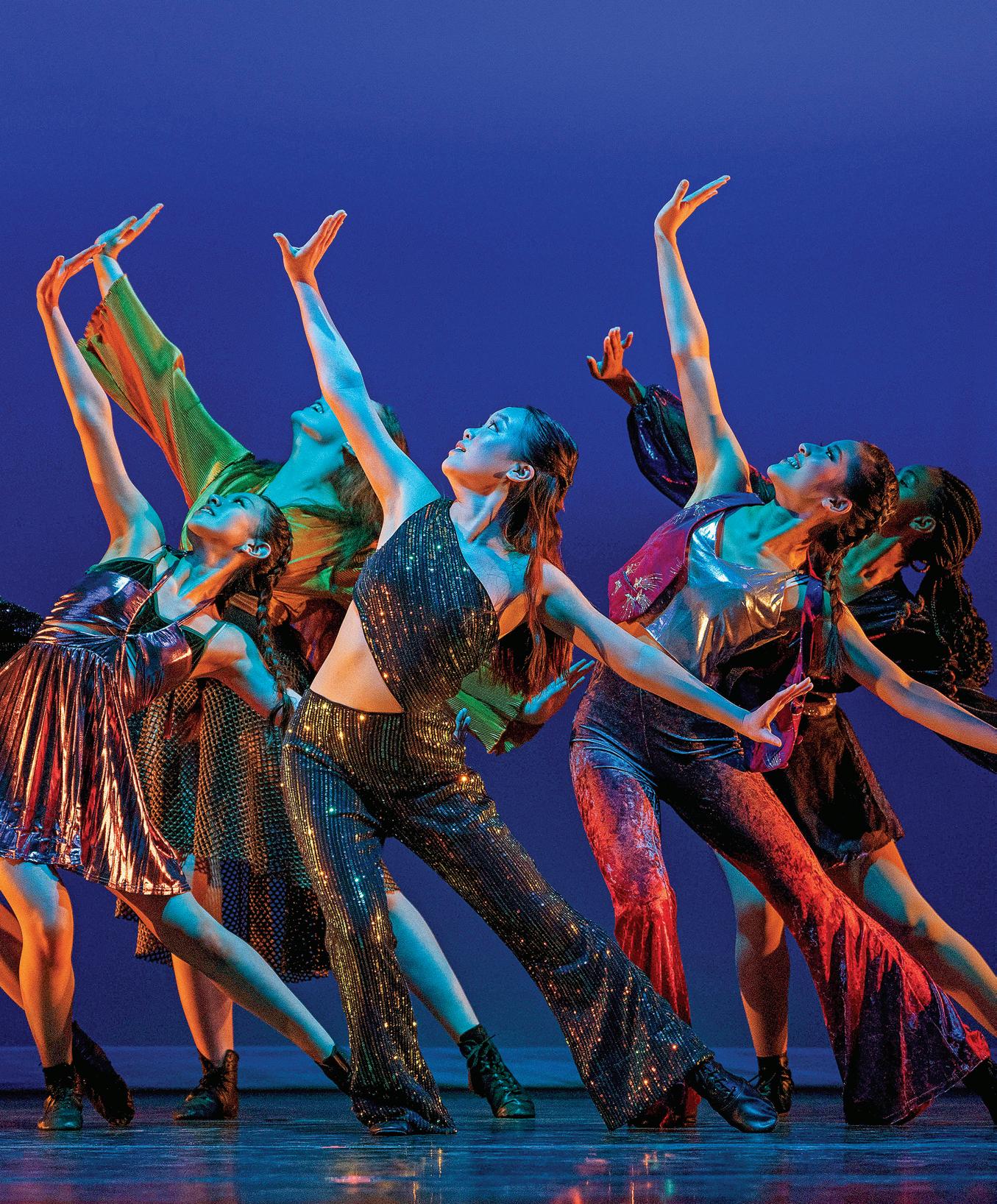



This fall, English Department Head Eileen Fenn Bouffard ’98 delivered a Morning Meeting talk about technology—the way it has changed at Taft and the impact that change has had on our students and school community. The following is excerpted from that talk.
Every year I have my senior students write me a letter for their first homework assignment. In the letter, they have to introduce themselves; they are asked to explain why they want to take the class, and what they love about English. So, after a few excellent introductory classes, I began reading the letters, which were thoughtful and detailed, but I noticed this repeated reference to technology, one that I hadn’t observed in previous years. One student wrote, “My use of technology has really impacted the way I write.” Another included the line, “I used to be able to read for longer periods of time, and while I still like to read, it’s not as easy as it was when I was younger, before I had my iPhone.” A few other authors detailed how they felt generally distracted and worried about how they would adjust their device use now that the summer was over. I found these reflections to be really curious, as I hadn’t even asked my students to consider their relationship to technology or how it might relate to their work in class as part of the assignment; it was just something on their minds. And honestly, my use of technology—particularly my reliance on my phone—is something that I spend a lot of time thinking about, too.
I marked a few important milestones in 2023. For instance, this is my 20th year of teaching. This spring, I celebrated my 25th Reunion with fellow graduates of The Taft School Class of 1998. In many ways, my professional career runs parallel to the emergence and rise of social media and smartphones. Given my experience with digital technologies and my familiarity with Taft both before and after their emergence, I want to share some of my experiences with how the school—and our time in it—is shaped by our technology use. I also want us to question our use of technology as both a community and as individuals.

As recently as the late 1990s, all communication at Taft was paper-based and largely centralized. Team practice schedules as well as club meeting times and locations were posted on Main Board, which was very much connected to assembly, so people would make announcements about clubs or groups or games on Wednesday or Saturday mornings, and then add, “Check Main Board for the details.” In my memory there was always a group of students clustered in front of and staring at the bulletin board adjacent to the mailroom. In fact, the nearby mailroom, which not only handled and hand-delivered everything from birthday cards to

My weekly screen report showed that I was somehow still spending five hours a day on my phone. So what is going on here?”


Our device use has collective implications on our ability to empathize and be fully present with each other.”
college application materials, also provided a small stack of paper on the counter that allowed students to write and leave notes to each other throughout the day. More paper came in the form of classroom handouts. On the first day of classes, we received a syllabus for the semester; I cannot recall a teacher ever making anyone an additional copy, and we lived in fear of losing this critical document. There was one computer lab in the main building, and there was approximately one pay phone per dormitory. Because of these realities, boundaries between home and school were much more delineated. At school, we were often unreachable and could be out of contact, even with friends on the same campus, for hours at a time. Nonetheless, whenever a movie was played in Bingham on a Saturday night—which was often—almost the entire school was there, even if you didn’t really want to watch the movie, because streaming services like Netflix weren’t an option, and the size of the TVs in the dorms were not very conducive to group viewing. Our desperation for
entertainment was such that advisors would occasionally offer to record a popular TV show on VHS during study hall so we could watch it the next day.
Now, things are much more diffuse and boundaries have broken down due to device use. In fact, a 2022 study by The Pew Research Center found that 46% of teenaged participants described their internet use as “constant.” We can observe this reality in our use of spaces across campus throughout the class day. You can check assignments as many times as you like on Canvas, our learning management system. You can email friends from all over the world while walking to math class. You can text family members while eating lunch and watching a sitcom on your laptop in the dining hall. Twenty-five years after I graduated from a paper-based school, we expect quick responses from all contacts. Entertainment options are much more individualized. We are immediately notified of world and domestic events on our screens. Social media allows us to present a carefully curated version of ourselves to the world. We can gather so much information without even moving from our chairs. This is all very convenient, right?
Back in May last year, as members of the Class of 1998 were “doing it for the gram” and gathering together to take group photos, a topic we kept returning to was how thankful we were that social media did not exist when we were students at Taft, that we in fact only occasionally posed for pictures as teenagers, that our parents didn’t expect to hear from us for long swaths of time, that home was home and school was school, that we did not, as adolescents, have to contend with the innumerable distractions that an iPhone now brings to our adult lives.
Given the parallel track between my career and the rise of smartphones, I have always been really interested in talking with students about social media and their device use. Now, I want to be totally transparent: I text way too much. And I love social media. I LOVE it. Like many of us, I spend far too much time on it. But, as much as I love it, when I read those letters from my students, that was the tipping point: I took Instagram and Facebook off my phone. Yet, as recently as two weeks ago, my weekly screen report showed that I was somehow still spending five hours a day on my phone. So what is going on here?
Bigger questions have been lurking in the background for me—for a few years now—and reading those reflections brought them into crystalline focus: What is happening to me given my device use? How is this related to my environment?
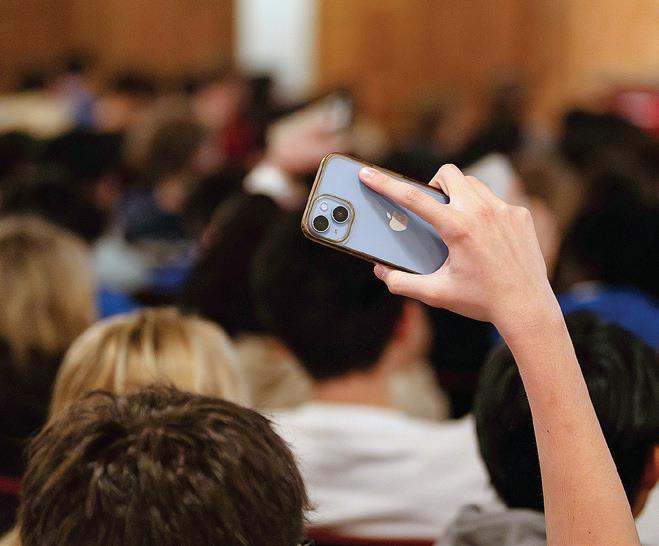
My ongoing wondering about device use and its impact led me to design and teach a senior English elective called Media and Identity. Since it first ran in the fall of 2019, I have been amazed at my students’ willingness to candidly write about and discuss their phone use. They alternately resent and feel compelled by their phones and how social media has created a “third rail” of expectations, pressures, and experiences. In fact, they worry about younger students and siblings given their digital media consumption. Notably, none of my students has ever said they wished they got a smartphone at an earlier age or that they aspired to spend more time on social media.
In his book Stolen Focus, Johann Hari refers to this concept as “living in the gap”: We know that our internet and device use are problematic, and yet we just can’t seem to do anything about them. Part of the reason why this is so hard is because there are wildly powerful forces behind these technologies that have developed digital experiences designed to steal our time and divide our attention because it is extremely profitable. And I want to make it clear: Although things were different in the ’90s, there were always distractions. I mean, we were checking our
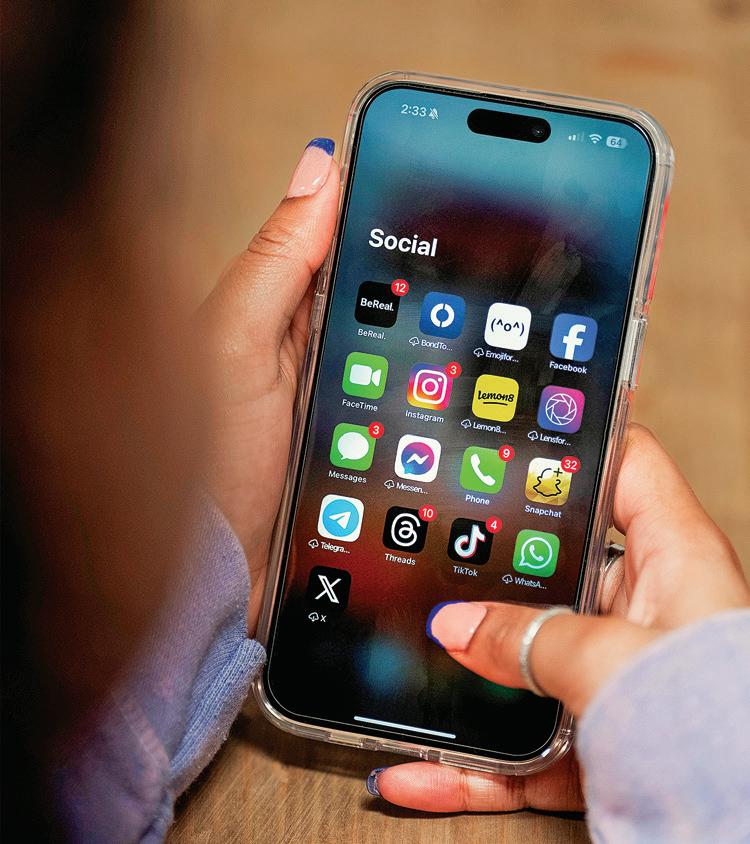
mailboxes 20 times a day. Distraction is a part of life. However, all sense of normal distraction has been accelerated in our new hyper-connected reality. Our attention seems to be constantly fractured. As Sherry Turkle wrote in her book, Reclaiming Conversation: The Power of Talk in a Digital Age, “Because of our phones, we are forever elsewhere.” Let’s consider a few real-life examples of this and their impact.



The research is clear: Humans cannot multitask; in fact, this was a term developed to describe computer processors in the 1960s. The cost of constant switching—say you get a text message in the middle of reading your English homework during study hall—is that you not only lose focus, but your brain has to recenter and remember what you were doing before.
It is sort of like when a boat gets tipped slightly off balance; it needs time to right itself again. When this happens, your performance drops, you’re slower. So when you’re checking text messages while trying to study, you lose time to texting, but you also lose the time it takes to refocus afterward. So while my Screen Time shows I am using my device for five hours a day, I’m actually losing much more time than that because I have to constantly refocus on the tasks at hand. Simply having your phone on and looking at it means that you are switching tasks. Other research studies show that having a smartphone within sight or within easy reach reduces a person’s ability to focus and perform tasks because part of their brain is actively working to not pick up or use the phone.
Here’s a related scenario. You’re walking towards a teacher or student you don’t know. Do you think about glancing at your phone a few times to avoid eye contact? Looking at your phone is a guaranteed dopamine hit, and it can often feel like the easier choice than a real-time, potentially “awkward” encounter. Relatedly, psychologist Catherine SteinerAdair found in her 2013 study that many adolescents refuse to communicate face to face and prefer to conduct their disagreements by texting instead. Our device use has collective implications on our ability to empathize and be fully present with each other.
We can see this writ large in other everyday interactions. For instance, let’s say you’re chatting with a friend. Your friend gets a text. They look at their phone, and their focus is increasingly consumed by their phone. What do you do? You take out your phone. This is a phenomenon known as “phubbing”: snubbing + phone. Habitual phubbing leads to lower relationship satisfaction and it also leads to more phone use. So, when we see a lot of phone use around us, we tend to then look down and use our own phones more.
Where does this leave us in the big picture? Nationally, empathy has declined; we are less likely to take the perspective of other people or demonstrate concern for others. We learn empathy and understanding by watching how actions affect other people, and you can’t really do that behind a screen or device, particularly if you habituate social media sites that simply reflect back what you already believe like some kind of digital echo chamber. Jaron Lanier wrote in his book, Ten Reasons for Deleting Your Social Media Accounts Right Now, “We see less than ever before of what others are seeing, so we have less opportunity to understand each other.” Given the reality
 The all-important Main Board in the 1980s
The all-important Main Board in the 1980s
of phubbing, our individual use of devices really does impact community-wide use. So, if we’re going to embrace kindness as our Head Monitors Julian Prentice and Maya Lewis charged at the beginning of this year, one of the kindest things we can do for our brains, our psyches, and our community is to reflect upon our individual and collective smartphone use.
Now, I’m not saying the ’90s were utopian, but I hope we might consider the following elements of device use over the next few months individually and together:
1. Read the terms and conditions for a social media platform that you use. You don’t have to give it up, but you might be surprised to learn what the platform can do with your images and content.
2. Like all Taft teachers, I have my students leave their phones by the door at the start of each period. But if you’re grabbing your phone at the end of a class like you’re coming up for air after being under water, and you’re using your phone all the way to the next class, you’re setting up your brain for another cognitive switch that extends into the next period. So, take one day and commit to leaving your phone in your room. Or give your phone to the faculty member on duty during study hall. Give it a try. See how it goes.
3. Boredom is a gift. Don’t fill it with scrolling. Just think. Just rest. Mind wandering is when you can be your most creative. Boredom is a gift. Don’t fill it with scrolling. Just think. Just rest. Mind wandering is when you can be your most creative.”

4. Consider not using your phone in the hour before you go to bed. Put it somewhere far away from where you sleep. Most professional athletic teams employ sleep coaches to further emphasize these habits.
5. Offload that one app. You probably already know which one you need a break from.
At one time or another, we have ignored someone we care about or been ignored by someone we care about in favor of devices. But it doesn’t have to be like this, and I’m going to keep working on it—I’m down to three hours of ScreenTime a day these days—and I hope you work on it, too. Emily asked in Thornton Wilder’s classic play, Our Town, “Does anyone ever realize life while they live it...every, every minute?” Each of us only has one mind. We only get a handful of moments together. Let’s appreciate how special that is. Let’s look each other in the eye. Let’s do the hard things, not the convenient things. Let’s be here now. Our attention is the most precious gift we can offer each other, and I thank you for yours this morning. B

A repurposed closet organizer stores phones during class.

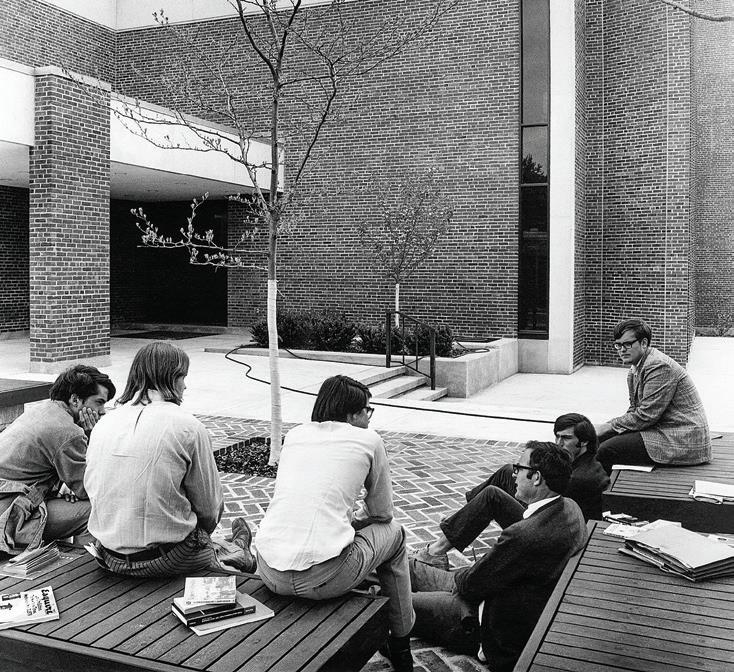

1. Fresh air helped with some lab assignments last year.
2. This photo was taken shortly after the Hulbert Taft Jr. Library opened in 1968. The patio made the perfect outdoor classroom!
3. Some subjects lend themselves to a classroom without walls and whiteboards in 2017.
4. A warm sunny afternoon on the Jig Patio helps keep the discussion flowing in 2019.
4
On a nice spring or fall day, there isn’t anything students like hearing more than “Let’s meet outside today.” We are very lucky to have one of the best “outdoor classrooms” around! From I-Block classes on the Jig Patio to environmental science and history classes pondside, generations of Tafties have enjoyed the best 226-acre classroom in Connecticut.
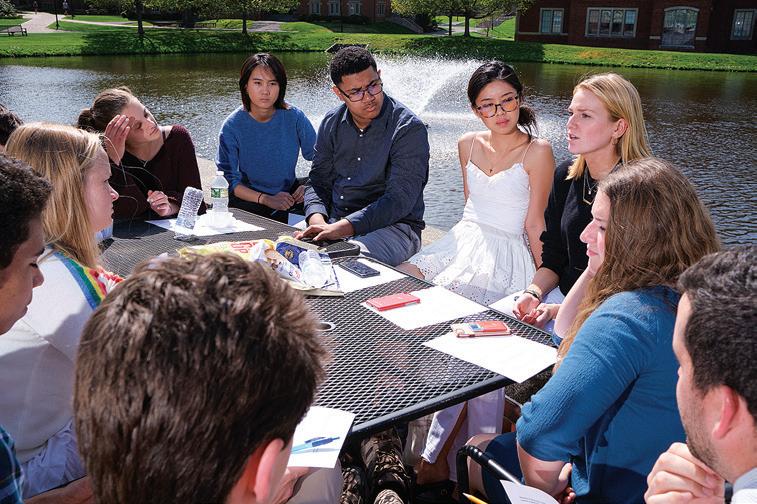 —Beth Nolan Lovallo ’93
—Beth Nolan Lovallo ’93
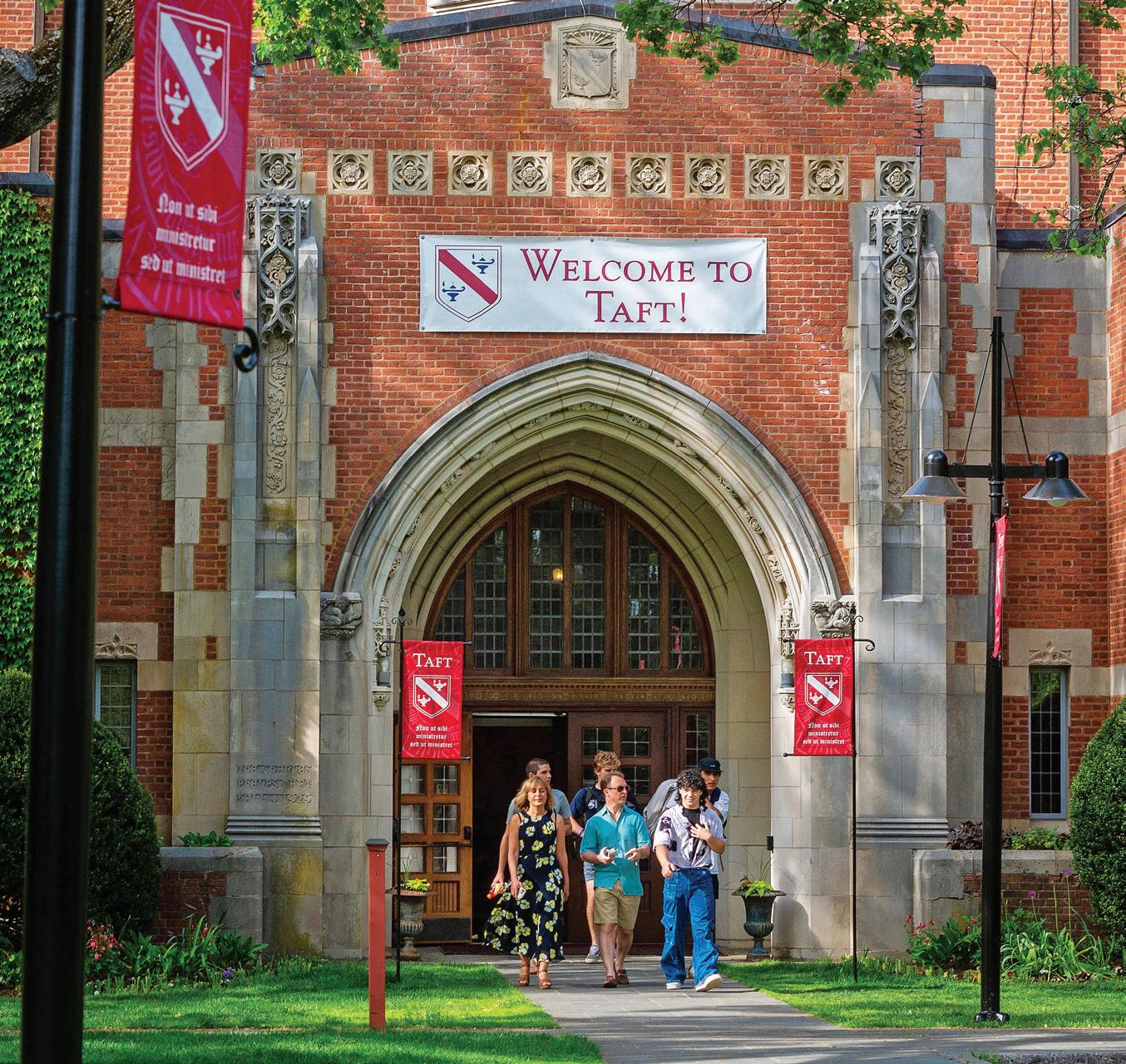
860-945-7777
taftschool.org/bulletin
